Netgear orporated 09300118 Powerline AV 200 Wireless-N Extender User Manual
Netgear Incorporated Powerline AV 200 Wireless-N Extender
User Manual
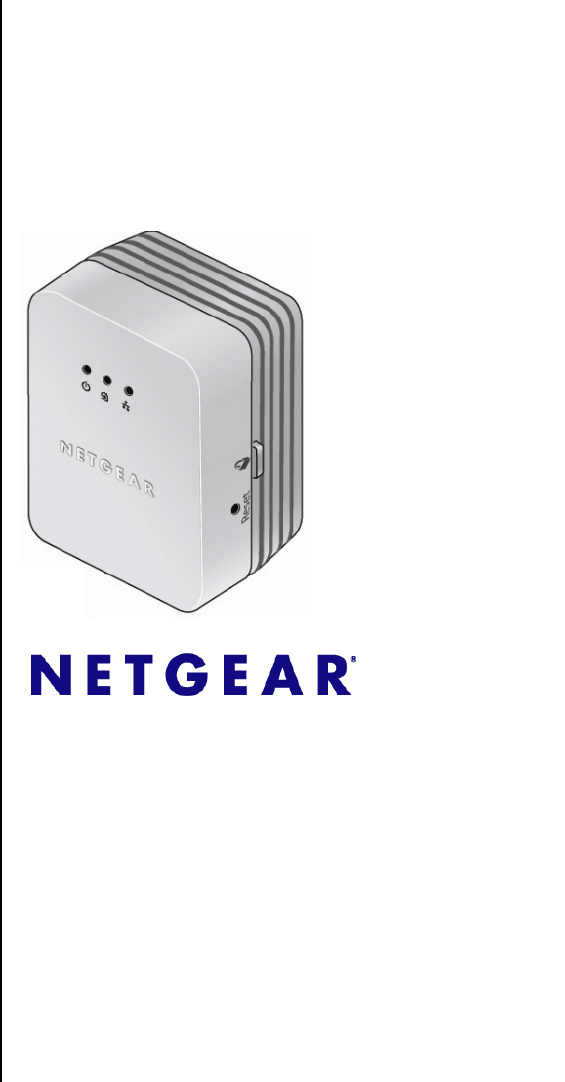
202-10547-01
v1.0
July 2010
NETGEAR, Inc.
350 East Plumeria Drive
San Jose, CA 95134 USA
XAVN2001 Powerline AV
200 Wireless-N Extender

XAVN2001 Powerline AV 200 Wireless-N Extender User Manual
ii
v1.0, July 2010
© 2010 by NETGEAR, Inc. All rights reserved.
Technical Support
Registration on the website or over the phone is required before you can use our telephone support service. The phone
numbers for worldwide regional customer support centers are on the Warranty and Support Information card that came
with your product.
Go to http://kbserver.netgear.com for product updates and Web support.
Trademarks
NETGEAR, the NETGEAR logo, ReadyNAS, X-RAID, X-RAID2, FrontView, RAIDar, RAIDiator, Network Storage
Processor, and NSP are trademarks or registered trademarks of NETGEAR, Inc. Microsoft, Windows, Windows NT and
Vista are registered trademarks of Microsoft Corporation. Other brand and product names are registered trademarks or
trademarks of their respective holders.
Statement of Conditions
In the interest of improving internal design, operational function, and/or reliability, NETGEAR reserves the right to
make changes to the products described in this document without notice.
NETGEAR does not assume any liability that may occur due to the use or application of the product(s) or circuit
layout(s) described herein.
Certificate of the Manufacturer/Importer
It is hereby certified that the XAVN2001 Powerline AV 200 Wireless-N Extender has been suppressed in accordance
with the conditions set out in the BMPT-AmtsblVfg 243/1991 and Vfg 46/1992. The operation of some equipment (for
example, test transmitters) in accordance with the regulations may, however, be subject to certain restrictions. Please
refer to the notes in the operating instructions.
The Federal Office for Telecommunications Approvals has been notified of the placing of this equipment on the market
and has been granted the right to test the series for compliance with the regulations.
Bestätigung des Herstellers/Importeurs
Es wird hiermit bestätigt, daß dasXAVN2001 Powerline AV 200 Wireless-N Extender gemäß der im BMPT-AmtsblVfg
243/1991 und Vfg 46/1992 aufgeführten Bestimmungen entstört ist. Das vorschriftsmäßige Betreiben einiger Geräte
(z.B. Testsender) kann jedoch gewissen Beschränkungen unterliegen. Lesen Sie dazu bitte die Anmerkungen in der
Betriebsanleitung.
Das Bundesamt für Zulassungen in der Telekommunikation wurde davon unterrichtet, daß dieses Gerät auf den Markt
gebracht wurde und es ist berechtigt, die Serie auf die Erfüllung der Vorschriften hin zu überprüfen.
Voluntary Control Council for Interference (VCCI) Statement
This equipment is in the Class A category (business use only) and conforms to the standards set by the Voluntary
Control Council for Interference by Data Processing Equipment and Electronic Office Machines aimed at preventing
radio interference in such residential areas. When used near a radio or TV receiver, it may become the cause of radio
interference. Read instructions for correct handling.

XAVN2001 Powerline AV 200 Wireless-N Extender User Manual
iii
v1.0, July 2010
FCC Statement
Federal Communication Commission Interference Statement
This equipment has been tested and complies with the limits for a Class B digital device, pursuant
to Part 15 of the FCC Rules. These limits are designed to provide reasonable protection against
harmful interference in a residential installation. This equipment generates, uses, and can radiate
radio frequency energy and, if not installed and used according to the instructions, may cause
harmful interference to radio communications. However, there is no guarantee that interference
will not occur in a particular installation. If this equipment does cause harmful interference to
radio or television reception, which is found by turning the equipment off and on, the user is
encouraged to try to correct the interference by one or more of the following measures:
• Reorient or relocate the receiving antenna.
• Increase the separation between the equipment and receiver.
• Connect the equipment into an outlet on a circuit different from that to which the receiver is
connected.
• Consult the dealer or an experienced radio/TV technician for help.
FCC Caution: Any changes or modifications not expressly approved by the party responsible for
compliance could void the user’s authority to operate this equipment.
This device complies with Part 15 of the FCC Rules. Operation is subject to the following two
conditions:
(1) This device may not cause harmful interference, and
(2) This device must accept any interference received, including interference that may cause
undesired operation.
For product available in the USA/Canada market, only channel 1~11 can be operated. Selection of
other channels is not possible.
This device and its antenna(s) must not be co-located or operated in conjunction with any other
antenna or transmitter.
IMPORTANT NOTE:
FCC Radiation Exposure Statement:
This equipment complies with FCC radiation exposure limits set forth for an uncontrolled
environment.
This equipment should be installed and operated with minimum distance 20cm between the
radiator and your body.

XAVN2001 Powerline AV 200 Wireless-N Extender User Manual
iv
v1.0, July 2010

i
v1.0, July 2010
Contents
About This Manual
Conventions and Formats ..................................................................................................i
Revision History ................................................................................................................. ii
Installation and Basic Configuration
How the Powerline AV Ethernet Adapter Fits in Your Network ......................................1-1
Powerline AV Ethernet Adapter Features .......................................................................1-2
XAV2001 Label ........................................................................................................1-2
LED and Feature Descriptions .................................................................................1-3
Installing Your Powerline AV Ethernet Adapter ..............................................................1-4
Connecting a Powerline AV Ethernet Adapter to the Router ..........................................1-5
Adding Adapters to Your Network ............................................................................1-6
Understanding Powerline Network Security ...................................................................1-7
Changing the Default Encryption .............................................................................1-8
Using the XAV2001 Powerline Utility
Installing the XAV2001 Powerline Utility .........................................................................2-2
Device Settings Tab .......................................................................................................2-5
Adding a Device to a Powerline Network .................................................................2-7
Security ...........................................................................................................................2-9
Changing the Network Encryption Key ..................................................................2-10
Setting Up a Custom Network Encryption Key .......................................................2-11
Returning to the Default Network Encryption Key ..................................................2-12
Quality of Service (QoS) ...............................................................................................2-13
Diagnostics ...................................................................................................................2-15
Factory Reset ...............................................................................................................2-16
Technical Specifications
Safety Information: XAV2001 Powerline AV Ethernet Adapter ..................................... A-2

XAVN2001 Powerline AV 200 Wireless-N Extender User Manual
ii
v1.0, July 2010
Troubleshooting
Product Registration and Support ................................................................................. B-1
Basic Functioning .......................................................................................................... B-1
LED Troubleshooting Tips ............................................................................................. B-2
Problems After Changing Network Encryption Key ....................................................... B-3
Changing the Network Encryption Key for One Unit at a Time ............................... B-4
Index
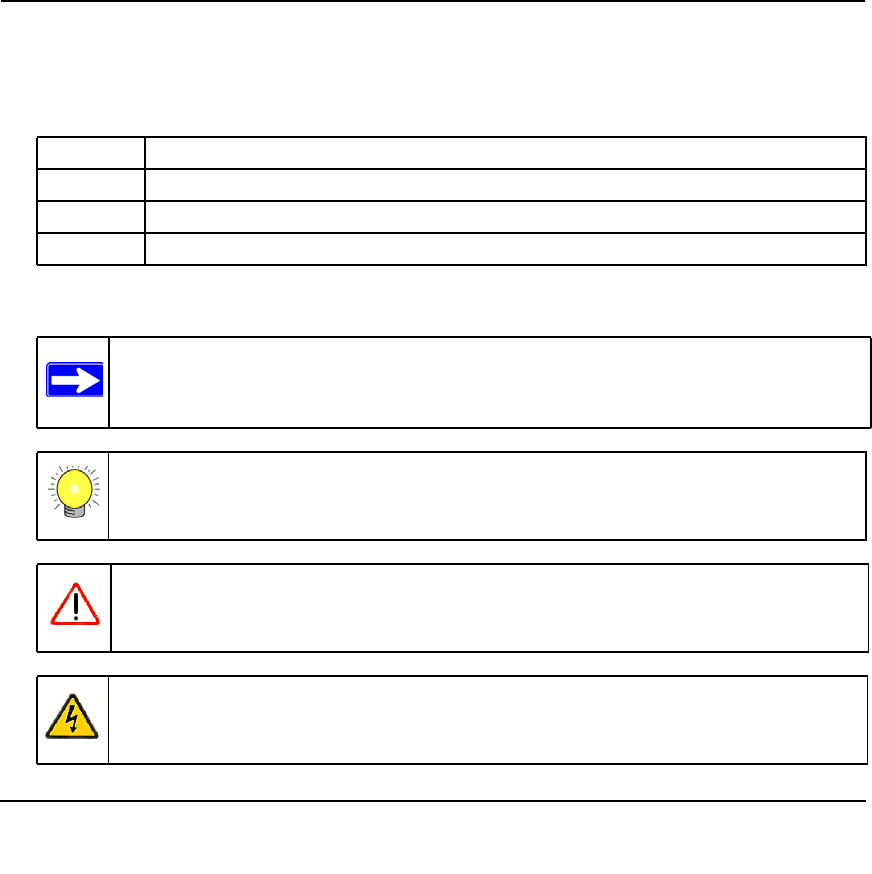
i
v1.0, July 2010
About This Manual
The NETGEAR® XAV2001 Powerline AV Ethernet Adapter User Manual describes how to
install, configure and troubleshoot the XAV2001 Powerline AV Ethernet Adapter. The information
in this manual is intended for readers with intermediate computer and Internet skills.
Conventions and Formats
The conventions, formats, and scope of this manual are described in the following paragraphs:
Typographical Conventions. This manual uses the following typographical conventions:
Formats. This manual uses the following formats to highlight special messages:
Italic Emphasis, books, CDs, file and server names, extensions
Bold User input, IP addresses, GUI screen text
Fixed Command prompts, CLI text, code
italic URL links
Note: This note highlights information of importance or special interest.
Tip: This note highlights a procedure that will save time or resources.
Warning: This note warns against a malfunction or damage to the equipment.
Danger: This safety warning warns against personal injury or death.

XAVN2001 Powerline AV 200 Wireless-N Extender User Manual
ii
v1.0, July 2010
Revision History
Part Number Version
Number Publication
Date Description
202-10531-01 1.0 July 2010 XAVN2001 Powerline AV 200 Wireless-N Extender User
Manual
First publication.

1-1
v1.0, July 2010
Chapter 1
Installation and Basic Configuration
This chapter describes how to install and configure the XAVN2001 Powerline AV 200 Wireless-N
Extender. It also explains the security features and how to customize the encryption key for added
security.
How the Powerline AV Ethernet Adapter Fits in Your Network
You can use one or more Powerline AV 200 Wireless-N Extenders to extend your Ethernet
network anywhere in your house using your existing electrical power lines. The illustration below
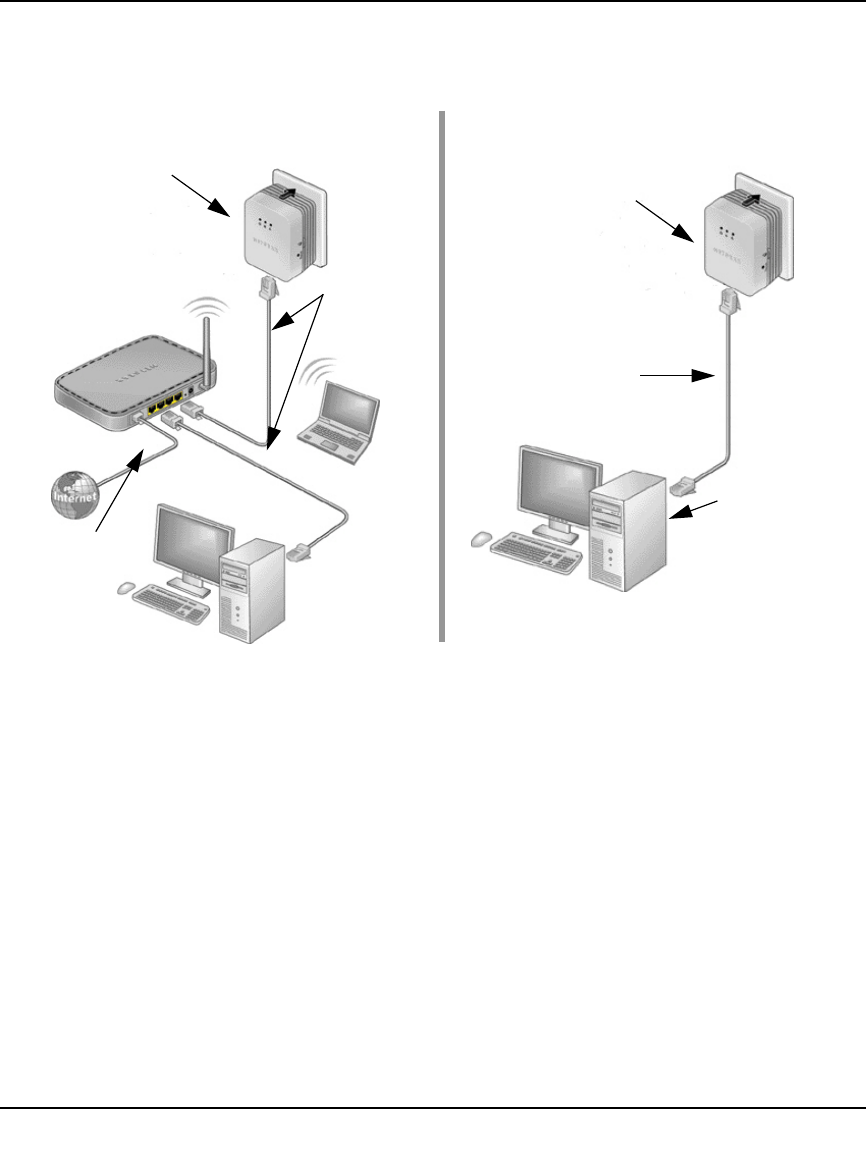
XAVN2001 Powerline AV 200 Wireless-N Extender User Manual
1-2 Installation and Basic Configuration
v1.0, July 2010
(Figure 1-1) shows an example of a Powerline network using a single Powerline device, which is
connected to an Ethernet network:
Figure 1-1 Powerline Adapter Connected to an Ethernet Network
Internet
connection
Ethernet
connection
XAVN2001
Desktop PC
Room 1 Room 2
XAVN2001
Ethernet
connection
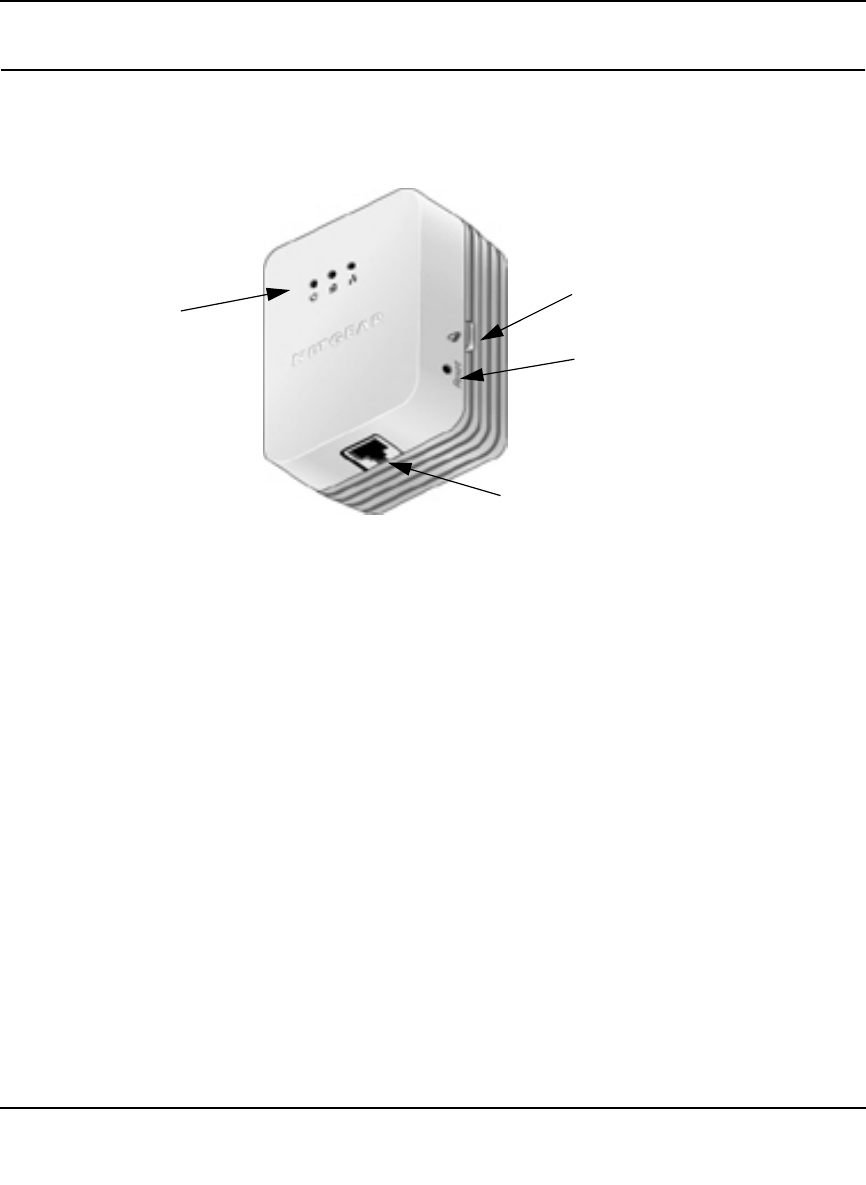
XAVN2001 Powerline AV 200 Wireless-N Extender User Manual
Installation and Basic Configuration 1-3
v1.0, July 2010
Powerline AV 200 Wireless-N Extender Features
The following illustration (Figure 1-2) shows the front and side panels of the Powerline AV 200
Wireless-N Extender:
XAVN2001 Label
The label on the rear panel of the XAVN2001 contains the items listed below.
• Model number
• MAC address
• Device password
• Serial number
Figure 1-2 XAVN2001 Powerline AV 200 Wireless-N
Extender
Ethernet port
LEDs
Security
button
Factory
Reset
button
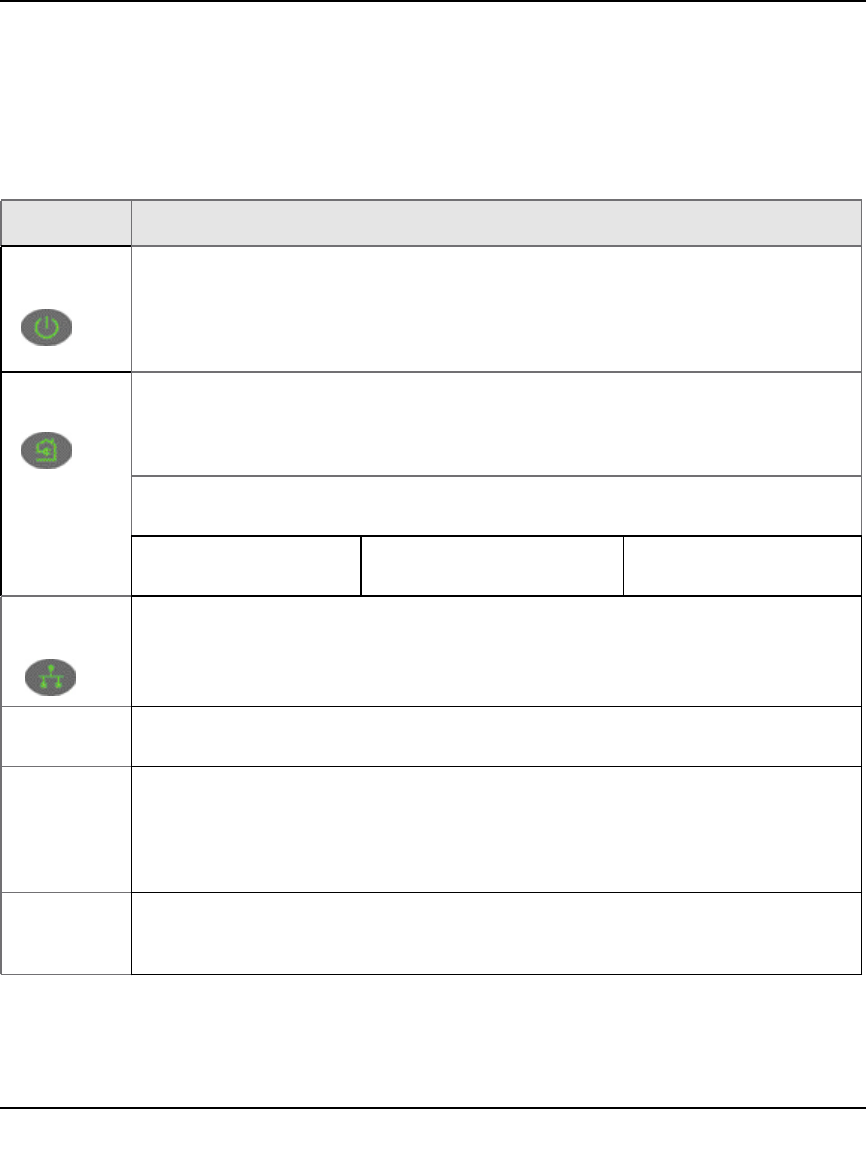
XAVN2001 Powerline AV 200 Wireless-N Extender User Manual
1-4 Installation and Basic Configuration
v1.0, July 2010
LED and Feature Descriptions
The following table describes the buttons, status lights, and Ethernet port on the XAVN2001
Powerline AV 200 Wireless-N Extender.
Table 1-1. XAVN2001 Feature Descriptions
Item Description
Power
LED
•Solid green. The electrical power is on.
•Blinking green.The adapter is in the process of restarting or setting up security.
•Amber. Power saving mode. The unit enters power saving mode if the Ethernet port is not
linked for more than 10 minutes.
•Off. There is no electrical power, or has been turned off through the Powerline utility.
Powerline
LED
•Solid. The adapter is connected to a Powerline network.
•Blinking. The adapter is sending or receiving data.
•Off. The adapter has not found any other compatible Powerline devices using the same
encryption key, or has been turned off through the Powerline utility.
The Pick A Plug feature lets you pick the electrical outlet with the strongest link rate, indicated
by the color displayed by the LED:
Green: Link rate > 80 Mbps
(Best) - Good for HD video
Amber: Link rate >50, <80 Mbps
(Better) - Good for SD Video
Red: Link rate < 50 Mbps
(Good) - Good for data
Ethernet
LED
•Solid. The Ethernet port is linked, but there is no activity.
•Blinking. There is traffic on the Ethernet port.
•Off. There is no Ethernet connection, or it has been turned off through the Powerline utility.
Factory
Reset
Press the Factory Reset button for 1 second, then release to return the Powerline adapter to its
factory default settings.
Security
Button
If you set security on your other adapters, after you plug your new AV adapter into the wall
socket, press its security button for 2 seconds; then press the security button on any adapter in
your existing network for 2 seconds. Both buttons must be pressed within 2 minutes.
Note: The Security button does not work in power saving mode. The unit enters power saving
mode if the Ethernet port is not linked for more than 10 minutes.
Ethernet Port Plug one end of the Ethernet cable that comes with the XAVN2001 Powerline AV 200 Wireless-
N Extender into this port and the other end either into your router, or into the computer or
other peripheral devices.
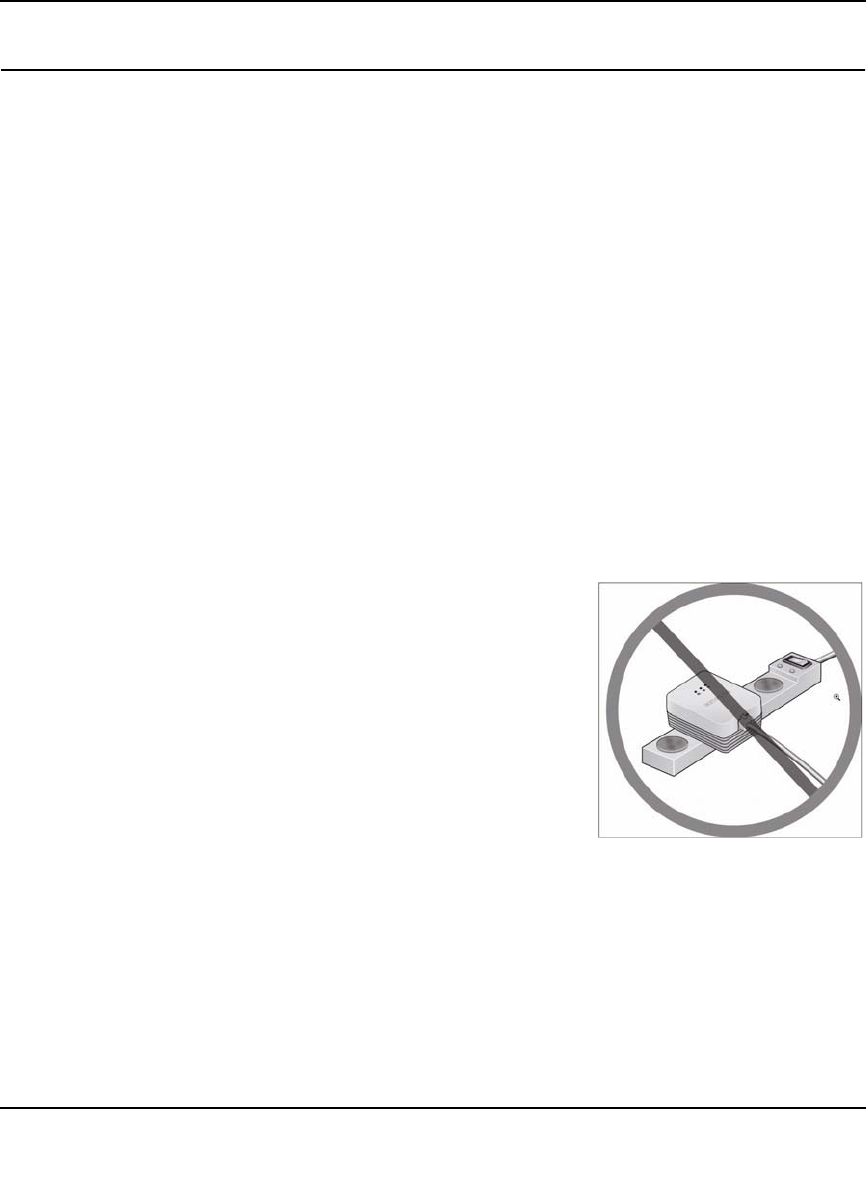
XAVN2001 Powerline AV 200 Wireless-N Extender User Manual
Installation and Basic Configuration 1-5
v1.0, July 2010
Installing Your Powerline AV Ethernet Adapter
Prepare for installation:
1. Before you begin, verify the following:
• Your Ethernet network is set up.
• An Ethernet port is available on your router.
• Your Internet connection is working.
• An Ethernet port is available on each computer that will use a Powerline AV 200 Wireless-
N Extender and is configured to work on your network. Usually, the default configuration
settings (TCP/IP and DHCP) are fine.
2. Familiarize yourself with the Powerline AV 200 Wireless-N Extender.
The front panel has three lights: Power, Powerline, and Ethernet. The side panel has a Security
button, and a Reset button. The Ethernet port is located on the bottom of the adapter. See
Figure 1-2 on page 1-2.
3. Plan the location of your Powerline devices:
• Use an electrical outlet that is not controlled by a wall
switch to avoid someone unknowingly turning off the
power to the outlet.
• Do not connect the Powerline AV 200 Wireless-N
Extender to a power strip, extension cord, or surge
protector as this might prevent it from working
correctly, or reduce the network performance.
• Avoid using the Powerline AV 200 Wireless-N Extender
in an electrical outlet that is located near an appliance
that uses a lot of power, such as a washer or dryer, or a
refrigerator. This could potentially prevent the adapter
from working correctly, or reduce network
performance.
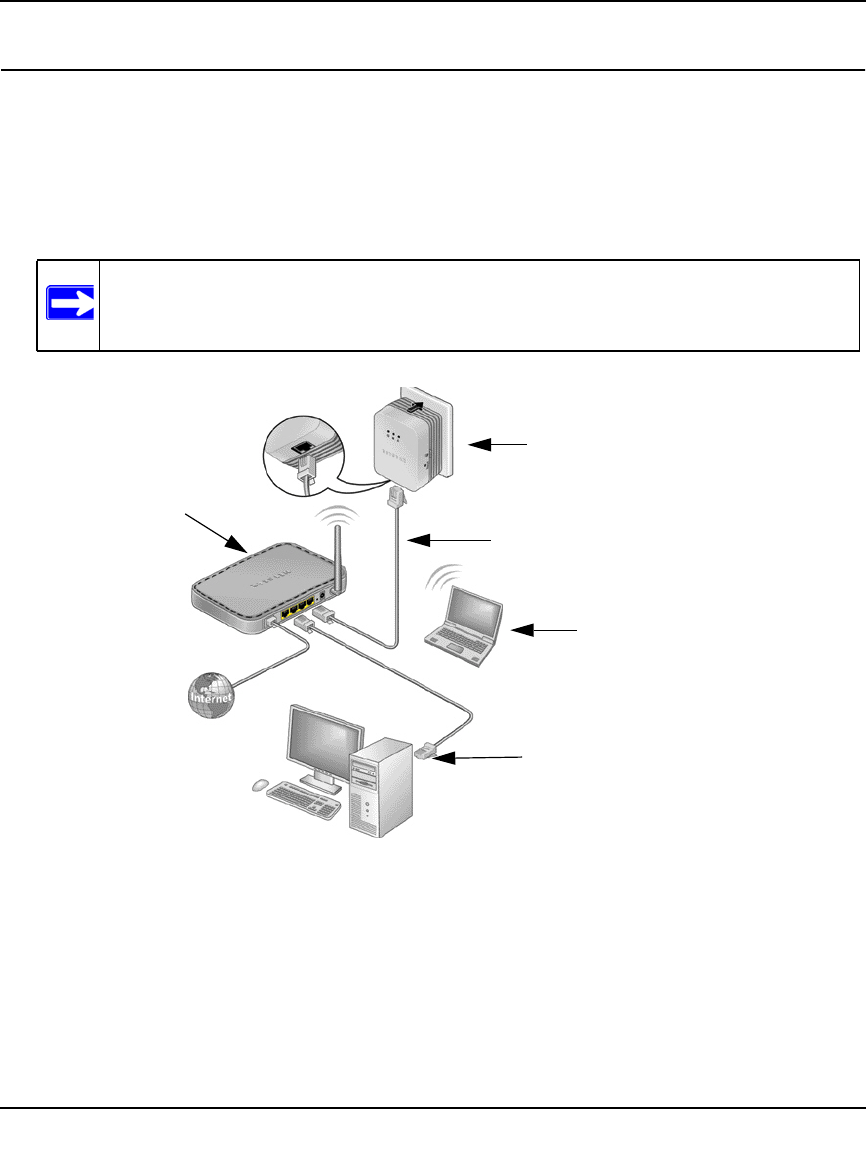
XAVN2001 Powerline AV 200 Wireless-N Extender User Manual
1-6 Installation and Basic Configuration
v1.0, July 2010
Connecting a Powerline AV Ethernet Adapter to the Router
1. Plug a Powerline AV 200 Wireless-N Extender into a power outlet near your router.
Use the supplied gray Ethernet cable to connect from the Adapter to a LAN port on your router
so that the Powerline network can gain access to the Internet. The Power and Ethernet lights
on the Powerline AV 200 Wireless-N Extender should turn on.
2. Once plugged in and power is first applied, check to see that the Power light is on.
3. After approximately 10 seconds, check to see that:
a. The Power light is solid green.
b. The Powerline LED is lit.
c. The Ethernet light is on or blinks.
Note: It is not necessary to disconnect your router from your computer.
Figure 1-3 Connecting the XAV2001 to a Router
XAVN2001 Powerline
AV 200 Wireless-N
Supplied Ethernet cable
Router
Laptop PC
Desktop PC
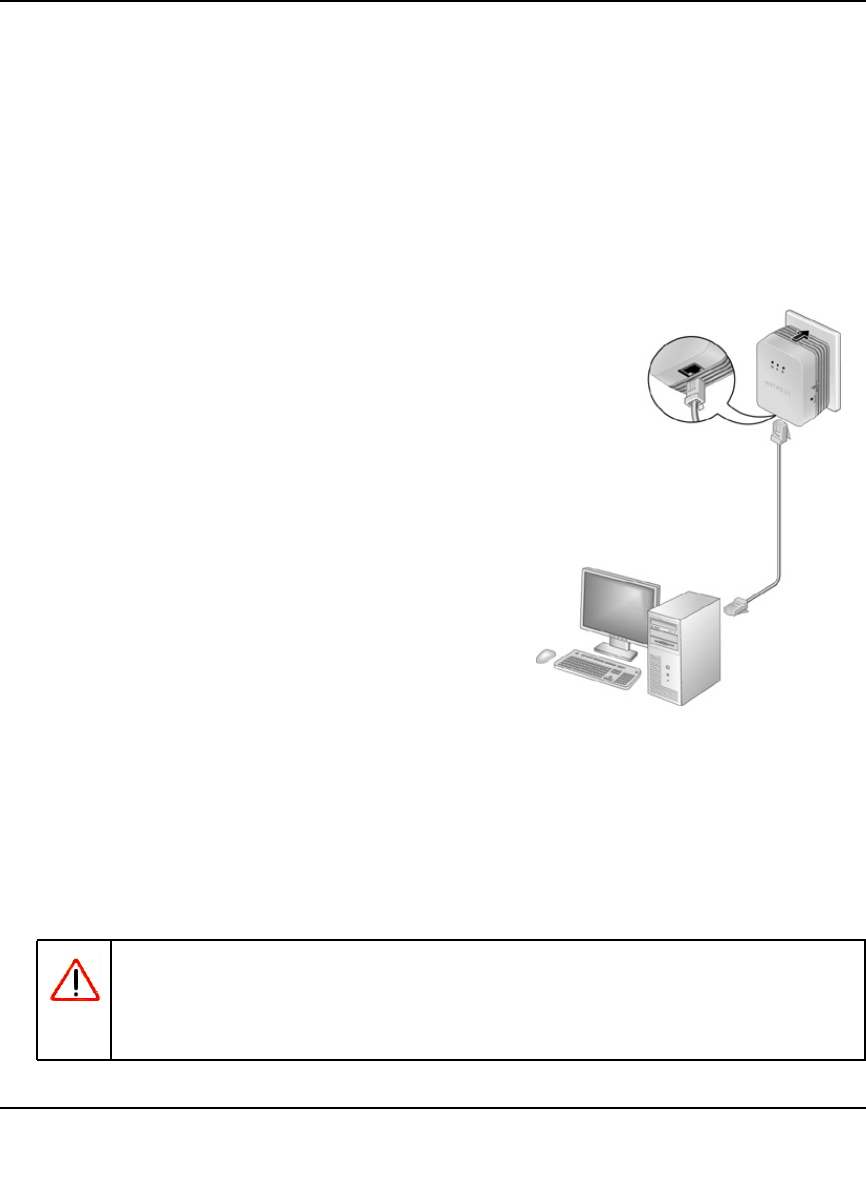
XAVN2001 Powerline AV 200 Wireless-N Extender User Manual
Installation and Basic Configuration 1-7
v1.0, July 2010
Adding Adapters to Your Network
Once the first adapter is installed and connected to your router, you can easily add adapters into
your network.
To add adapters:
1. Be sure the first adapter is connected to your router.
2. Plug additional Powerline AV 200 Wireless-N Extenders into power outlets near the other
computers and additional peripheral devices to be included in your Powerline network.
3. Use the gray Ethernet cable from the
XAVN2001 package to connect from the
Powerline AV 200 Wireless-N Extender to an
Ethernet port located on the other computer or
peripheral device.
4. Wait for each Powerline AV 200 Wireless-N
Extender to be recognized by the Powerline
network.
The Power, Ethernet, and Powerline lights
should turn on. This could take as little as 5
seconds, up to 80 seconds. For details about
how the lights work, see Table 1-1 on page 1-3.
5. Test to make sure that each computer connected
to a Powerline AV 200 Wireless-N Extender can
access the Powerline network.
For example, be sure that you can access the
Internet from a remote computer. If there is a
problem, see “Connecting a Powerline AV
Ethernet Adapter to the Router” on page 1-5.
One way to test this is to install the Powerline utility and use it to view all the computers
connected by the Powerline AV Ethernet adapter.
Warning: NETGEAR recommends that you secure your Powerline network from
unauthorized access. This is especially relevant in settings such as
apartment buildings. See “Understanding Powerline Network Security”
on page 1-7.
Figure 1-4 Add an adapter

XAVN2001 Powerline AV 200 Wireless-N Extender User Manual
1-8 Installation and Basic Configuration
v1.0, July 2010
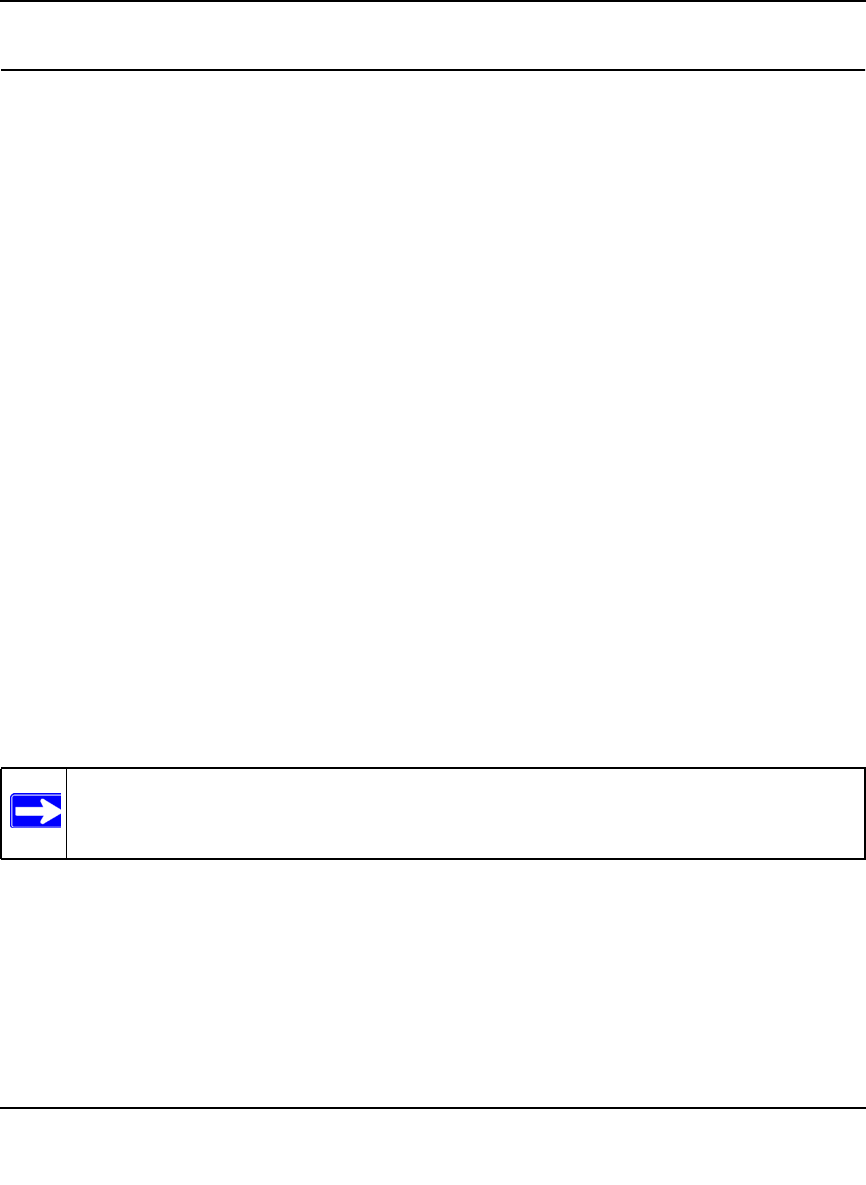
XAVN2001 Powerline AV 200 Wireless-N Extender User Manual
Installation and Basic Configuration 1-9
v1.0, July 2010
Understanding Powerline Network Security
A Powerline network consists of two or more Powerline adapters using the same network
encryption key. Securing your network is crucial. By encrypting the information you send over the
Powerline AV 200 Wireless-N Extender, you help to keep it secure from hackers. If you do not set
up security on your network, anyone nearby with a Powerline network can potentially use their
connection to gain access to your network and information you send over the internet. This is
especially relevant in settings such as apartment buildings, office buildings, dorm rooms, and other
more populated areas.
Powerline devices connected to the same network must use an identical encryption key. The
security used by Powerline AV 200 Wireless-N Extenders is similar to the SSID and encryption
keys used in wireless networks, but you do not need software to configure Powerline AV 200
Wireless-N Extenders.
There are two ways to secure your Powerline network.
• Use the Powerline AV 200 Wireless-N Extender Security button located on the adapter to
automatically generate a random encryption key. See “Changing the Default Encryption” on
page 1-8.
• Use the XAVN2001 Powerline Utility to configure your Powerline network with an encryption
key that you specify. If you are already using Powerline or HomePlug devices then you will
need to use the Powerline Utility. If not already installed, the Powerline Utility is located on
your Resource CD, and should be installed on your computer. See “Security” on page 2-9.
For information about using the XAVN2001 Powerline Utility to configure Powerline security
or to prioritize Powerline network traffic using the Quality of Service (QoS) feature, see
Chapter 2, “Using the XAVN2001 Powerline Utility.
Note: To return the XAVN2001 Powerline AV 200 Wireless-N Extender to its factory
default settings, see “Resetting to Factory Defaults” on page 2-16.
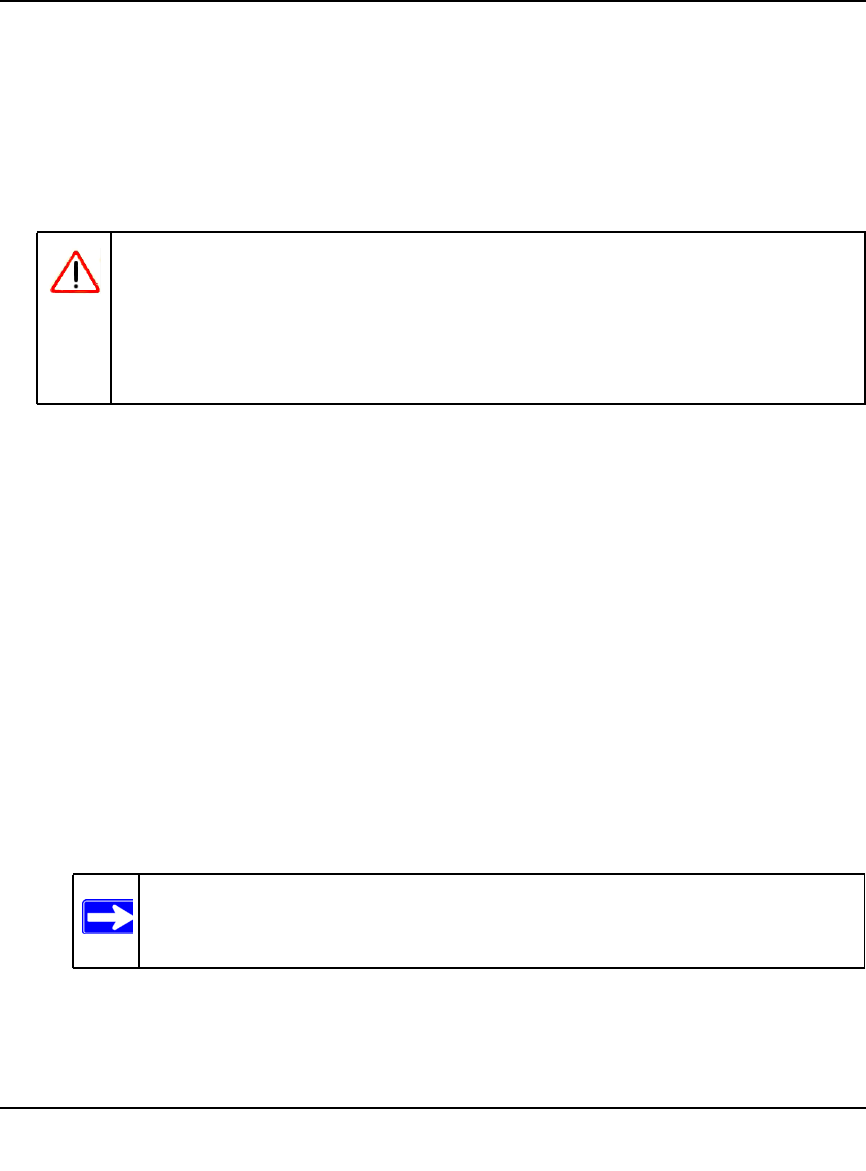
XAVN2001 Powerline AV 200 Wireless-N Extender User Manual
1-10 Installation and Basic Configuration
v1.0, July 2010
Changing the Default Encryption
You can use the security button to change the default encryption key and set a private encryption
key instead. The default encryption key is HomePlugAV.
To set a private encryption key:
1. Verify that all the Powerline AV 200 Wireless-N Extenders to be configured are plugged in.
2. On the first Powerline AV 200 Wireless-N Extender, press its security button for 2 seconds.
The power LED will start blinking after you release the button.
The adapter will automatically produce a new, randomly generated network encryption key
that each Powerline AV 200 Wireless-N Extender will use.
At this point, the other adapters in your network cannot communicate with each other.
3. Within 2 minutes of pushing the security button on the first adapter, push the security button
on the second adapter for 2 seconds.
In order to pair the devices, both buttons must be pushed within 2 minutes.
This securely configures your Powerline network with the same network encryption key.
4. If your network has more than 2 adapters, push the security button on the additional adapter
for 2 seconds, then push the security button on any additional adapters in your existing
network for 2 seconds. Both buttons must be pushed within 2 minutes. The adapters retain
security settings even if they are unplugged.
Warning: Do not press the Security button on the Powerline adapter until
installation is complete and all adapters on your network are plugged in
and communicating with each other. Pressing the Security button too
soon can temporarily disable Powerline communication. If this should
occur, reset the Powerline adapter to its factory default settings. See
“Resetting to Factory Defaults” on page 2-16.
Note: An adapter can only generate a private key once. To replace a private key,
first reset the adapter back to its factory defaults, then follow the procedure
above. See “Resetting to Factory Defaults” on page 2-16.

2-1
v1.0, July 2010
Chapter 2
Using the XAVN2001 Powerline Utility
This chapter explains how to install and use the XAVN2001 Powerline Utility. The Powerline
Utility is used for all Powerline AV products. All Powerline AV products (XAV101, XAV1004,
XAV2001, XAV2501, and XAVN2001) are compatible and can be installed on the same powerline
network.
The NETGEAR Powerline Utility can be used to:
• configure encryption for your Powerline network
• perform diagnostics and monitor performance
• set quality of service (QoS) features to prioritize Powerline network traffic
• reset adapters to factory default settings
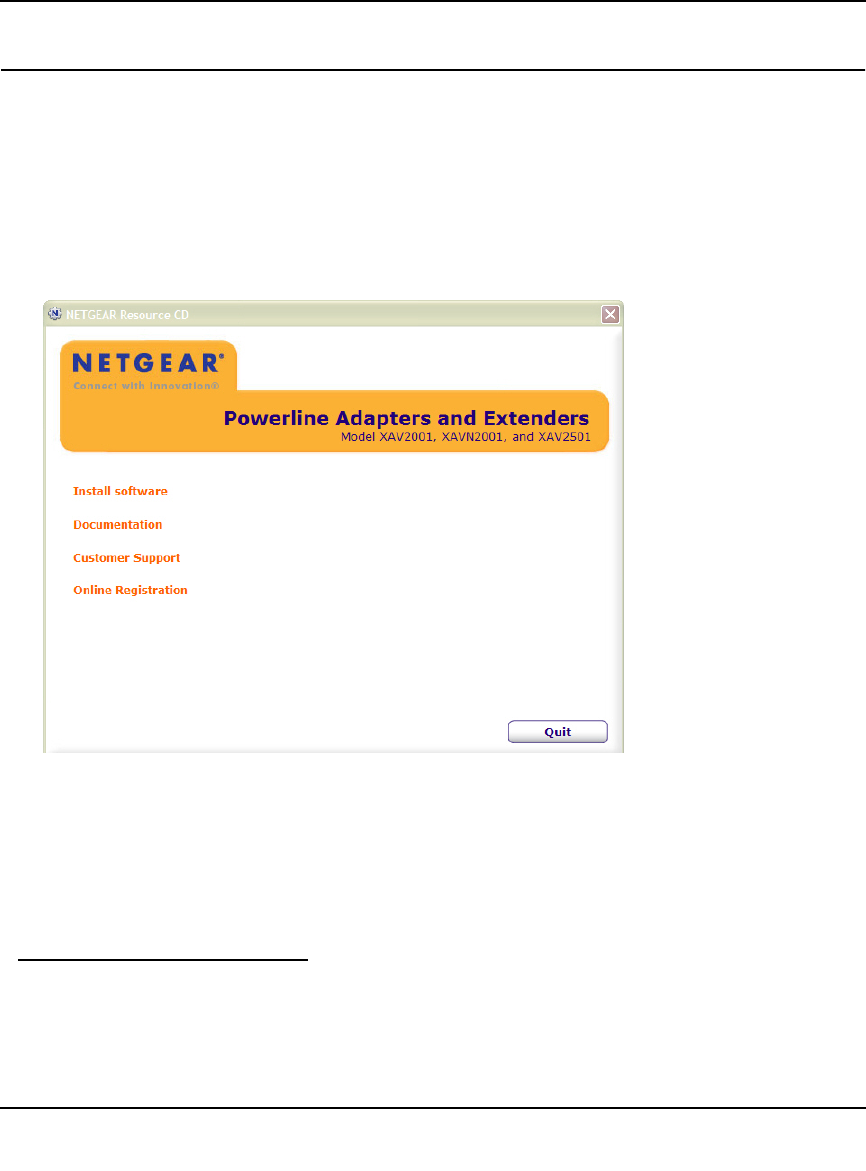
XAVN2001 Powerline AV 200 Wireless-N Extender User Manual
2-2 Using the XAVN2001 Powerline Utility
v1.0, July 2010
Installing the XAVN2001 Powerline Utility
This utility allows you to set your own unique Powerline network encryption key, and prioritize
traffic passing through your Powerline network.
To install the XAVN2001 Powerline Utility:
1. Insert the Resource CD into a CD drive on the computer that is connected to your router1.
The CD automatically starts and displays the following screen:
If the Resource CD does not start automatically:
• Go to My Computer on the Windows Start menu, and double-click the drive that
represents the location of the Resource CD or
• Select the CD drive, and click the Autorun.exe executable file.
1. All devices on a Powerline network can be managed from one computer. If you add another Powerline AV 200
Wireless-N Extender to a Powerline network, you can install the Powerline Utility on the computer connected
locally to the new adapter, or open the utility on the computer originally used to set up the Powerline network
encryption key. You can use any computer to manage the network, but this procedure assumes that you are
working from the computer that is connected to a powerline adapter.
Figure 2-1
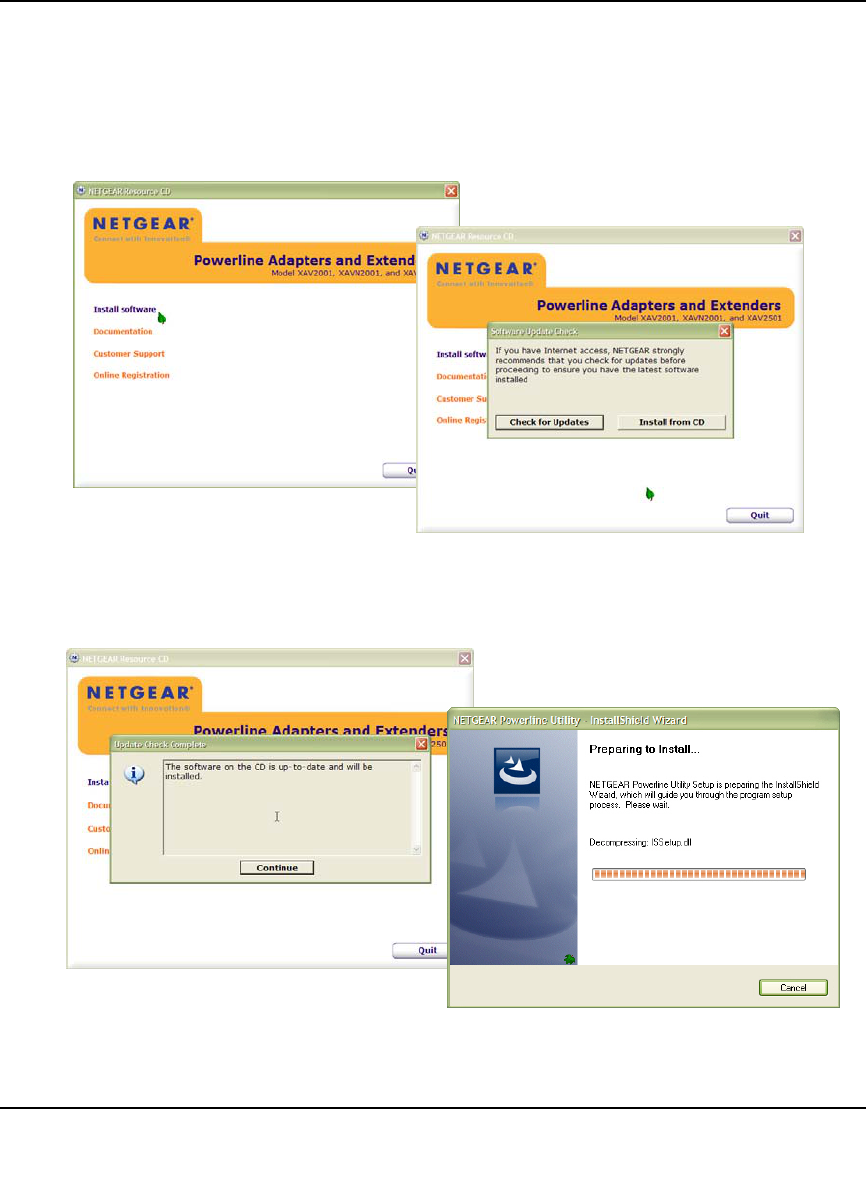
XAVN2001 Powerline AV 200 Wireless-N Extender User Manual
Using the XAVN2001 Powerline Utility 2-3
v1.0, July 2010
2. Click Install Software.
a. Check for Updates: Click this option to be sure you have the most current software.
b. Install from CD: Click this option to install the Powerline Utility from the CD.
3. Click Continue, and follow the wizard prompts.
Figure 2-2
Figure 2-3
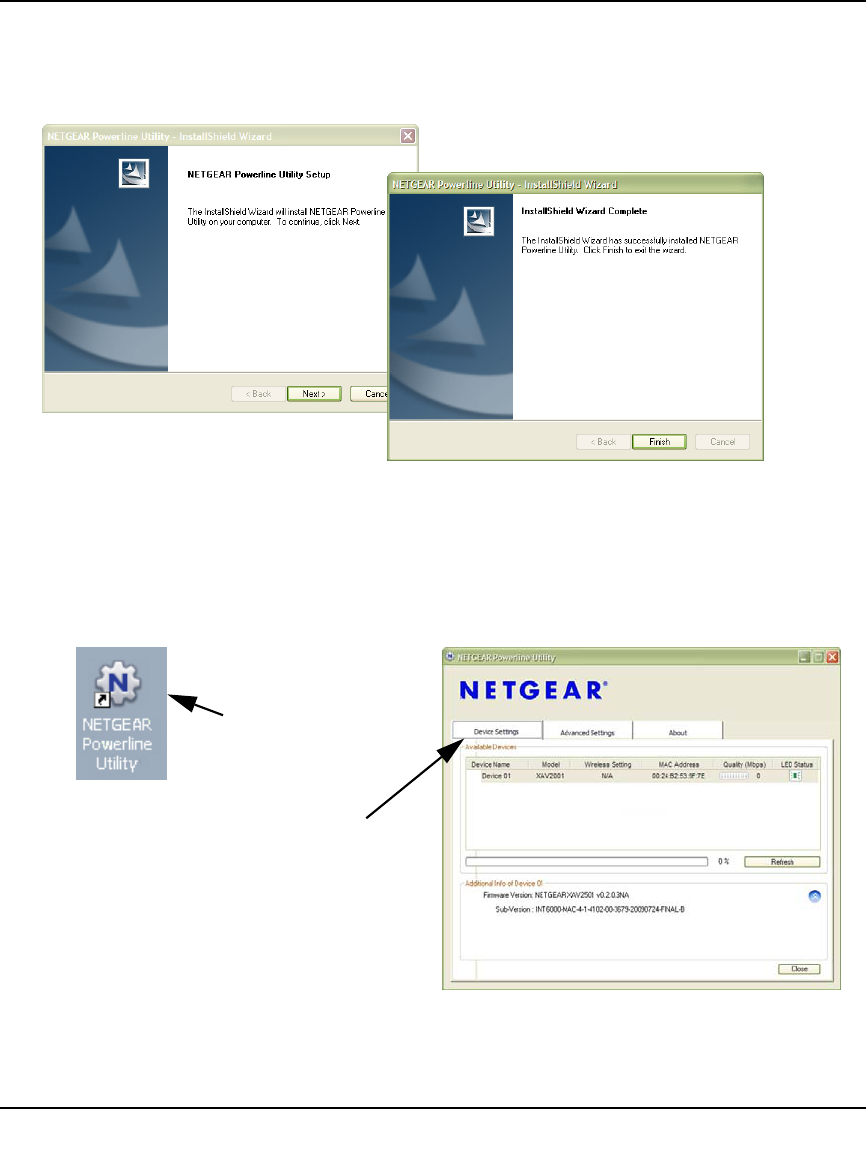
XAVN2001 Powerline AV 200 Wireless-N Extender User Manual
2-4 Using the XAVN2001 Powerline Utility
v1.0, July 2010
4. Click Next on the Setup Screen, and click Finish when the wizard is done.
The XAVN2001 Powerline Utility shortcut icon (Figure 2-5) will appear on your desktop.
5. There are two ways to launch the XAVN2001 Powerline Utility:
• Click the XAVN2001 Powerline Utility shortcut icon located on your desktop.
• Navigate to Start > Programs > NETGEAR > NETGEAR Powerline Utility.
Figure 2-4
Figure 2-5
Desktop
Shortcut
Icon
Powerline Utility
Landing Page
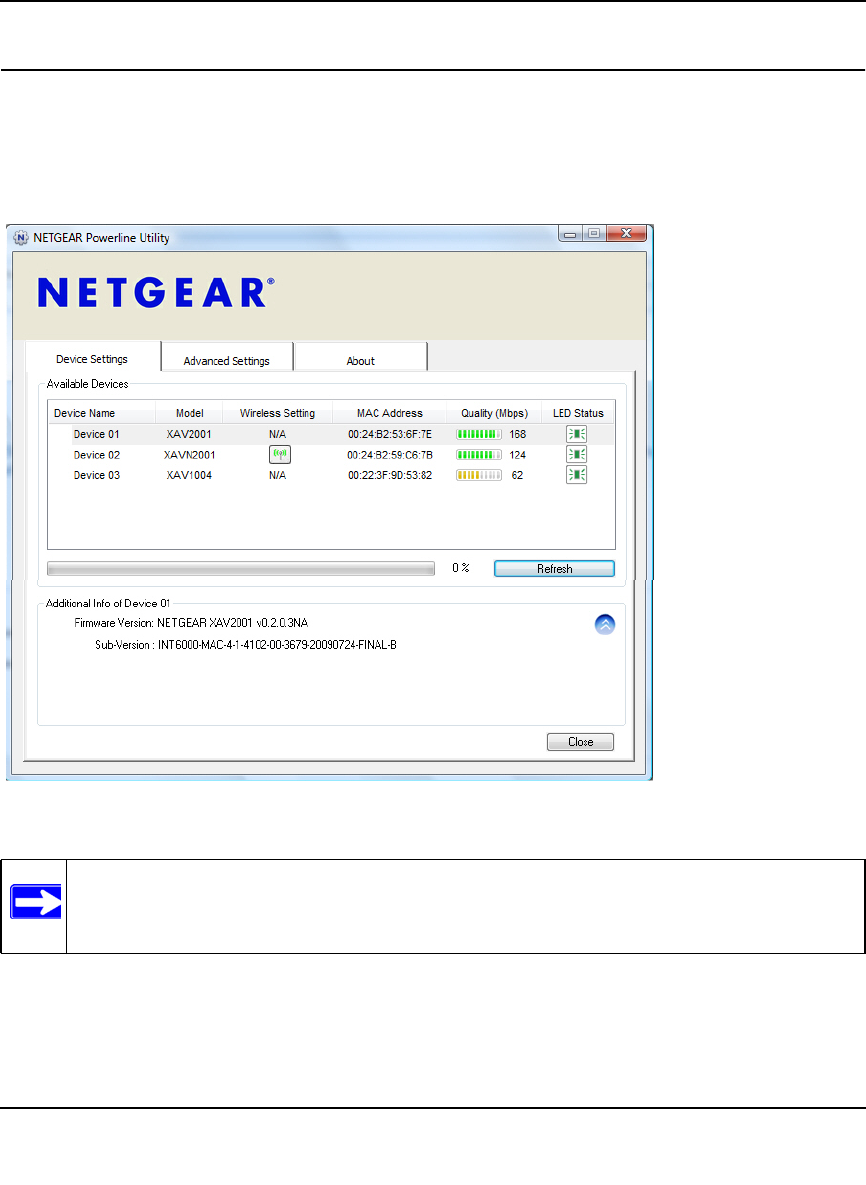
XAVN2001 Powerline AV 200 Wireless-N Extender User Manual
Using the XAVN2001 Powerline Utility 2-5
v1.0, July 2010
Device Settings Tab
When launched, the Powerline Utility opens to the Device Settings tab. If all devices are not
shown, click the refresh button to detect all Powerline Adapters on your network.
By clicking the LED status light you can toggle the LED between on and off.
Figure 2-6
Note: You may see a message at the bottom of the screen regarding the power saving
feature. If the unit goes into power saving mode, the Powerline Utility will not find
it. Keeping a connected Ethernet cable plugged into the device will keep it active.
4

XAVN2001 Powerline AV 200 Wireless-N Extender User Manual
2-6 Using the XAVN2001 Powerline Utility
v1.0, July 2010
The following table describes the features on the Device Settings Tab.
Table 2-1. Powerline Utility Device Settings Tab
Field or Button Description
Device Names This lists the Powerline devices detected on the network after the utility
completes a scan for devices. The device name is initially set by the utility, but
can be changed to reflect your specific adapter. For example, “Office” or “Master
Bedroom”.
Model This identifies the model number of the Powerline Adapter.
MAC Address The MAC address for the Powerline device. This is also on the product label,
which might not be visible when the device is plugged in.
Quality (Mbps) This indicates the type of traffic that can be handled smoothly and the link rate
for each Powerline device: HD Video, SD/DVD Video, or Data.
• HD Video. The device can handle high-definition video traffic smoothly. This
status will be shown if the transmit and receive link speed is greater than
80 Mbps.
• SD/DVD Video. The transmit and receive link speed is greater than 50 Mbps or
less than 80 Mbps.
• Data. The device cannot handle video data smoothly. This status will be shown
if the transmit or receive link speed is less than 50 Mbps.
LED On/Off button Enable or disable the LEDs for a Powerline device.The LEDs are enabled by
default.

XAVN2001 Powerline AV 200 Wireless-N Extender User Manual
Using the XAVN2001 Powerline Utility 2-7
v1.0, July 2010
Adding a Device to a Powerline Network
If you are adding a device to a Powerline network, and the network encryption key has been left at
its default setting, all you need to do is plug the new device into a power outlet.
If the network encryption key has been customized, there are two ways to set the security:
• You can use the Security button to add the new device to your network. See “Adding Adapters
to Your Network” on page 1-6.
• You can use the XAVN2001 Powerline Utility to add the new device to the network, as
described in the following sections.
The procedure for setting the network encryption key depends on whether the computer running
the XAVN2001 Powerline Utility is connected directly to the new Powerline AV 200 Wireless-N
Extender (local) or is connected to a different device in the Powerline network (remote).
To Add a Device from a Locally Connected Computer
1. Plug the new Powerline AV 200 Wireless-N Extender into an available AC power outlet.
2. Connect the Ethernet cable that came with the adapter to the adapter’s Ethernet port and an
Ethernet port on the computer.
3. Start the XAVN2001 Powerline Utility. This displays the Device Settings tab. Wait for the
utility to detect the new device.
4. Select the Advanced tab, and click the Security arrow.
5. From the Device Name column select the device.
6. Type the network encryption key into the Create a New Encryption Key field.
7. Click the Apply Security to Selected Devices button.
8. Select the Device Settings tab to perform a scan.
Verify that the devices in the Powerline network appear in the device list. It may take a minute
or two for all devices in the network to be detected.

XAVN2001 Powerline AV 200 Wireless-N Extender User Manual
2-8 Using the XAVN2001 Powerline Utility
v1.0, July 2010
To Add a Device from a Remotely Connected Computer
If you are using a custom network encryption key, set all the devices to the default network
encryption key of HomePlugAV so that they can communicate with each other. Then set all the
devices to the network encryption key that you want to use.
1. To change the encryption key for a remote device, you must enter the password for the device.
The password is printed on the product label.
2. Click the device name for a remote Powerline device to highlight it in blue.
3. Click Enter Password.
4. Enter the device password, and then click OK.
The device password is located on the product label.
5. From the Device Name column, select the device.
6. Type the network encryption key into the Apply the Encryption Key field.
7. Click the Apply Security to Selected Devices button.
8. Select the Device Settings tab. This will perform a automatic scan.
Verify that the devices in the Powerline network appear in the device list. It may take a minute
or two for all devices in the network to be detected.
Note: Be sure to change the password of remote devices before changing it on the
local device so that you can maintain connectivity throughout this process.
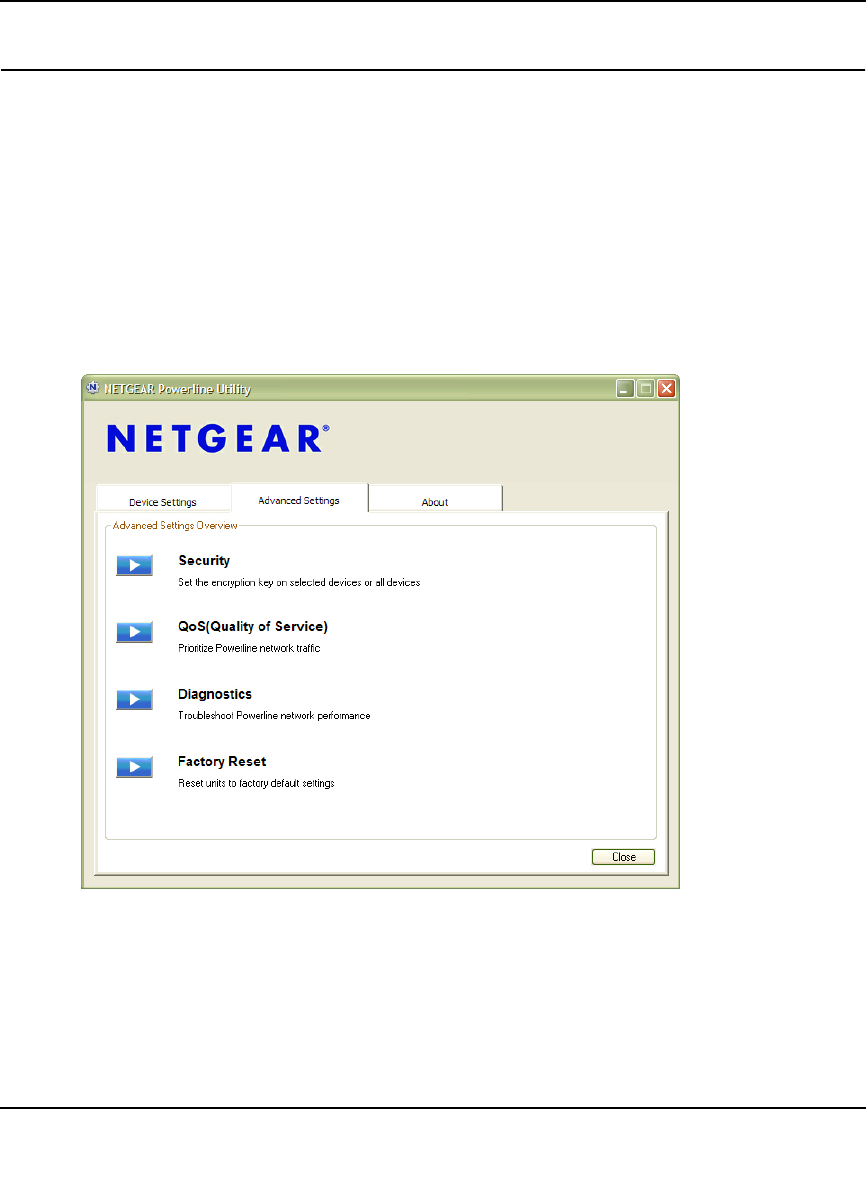
XAVN2001 Powerline AV 200 Wireless-N Extender User Manual
Using the XAVN2001 Powerline Utility 2-9
v1.0, July 2010
Security
From the Advanced Settings tab on the Powerline Utility you can perform a number of security
functions, such as:
• Changing the network encryption key
• Setting up a custom network encryption key
• Returning to the Factory Default Network Encryption Key
• Changing the Network Encryption Key for One Unit at a Time
Figure 2-7
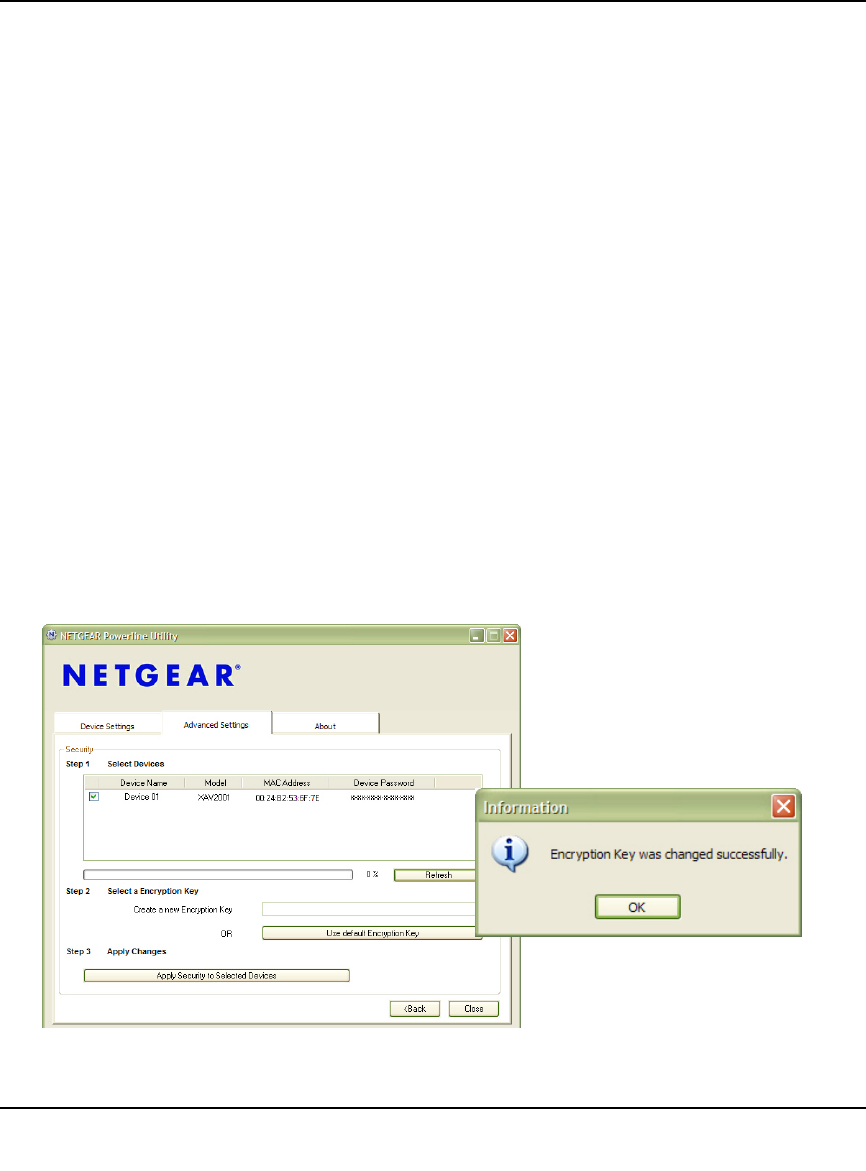
XAVN2001 Powerline AV 200 Wireless-N Extender User Manual
2-10 Using the XAVN2001 Powerline Utility
v1.0, July 2010
Changing the Network Encryption Key
You can specify the network encryption key from the Security tab.
1. From the Advanced Settings tab, click the Security arrow.
When all the devices are set to the default network encryption key and are plugged in, they are
listed on the Device Settings tab.
2. Check each box next to the Device Names that you want to add encryption.
Here you have two options:
a. Use the Default Encryption Key option
When you click this option, the factory default encryption key is automatically populated
in the field. The default network encryption key is HomePlugAV.
b. Create your own Encryption Key
This option lets you set your own network encryption key. Type your network encryption
key in the field provide.
3. Apply the changes by clicking the Apply Security to Selected Devices button.
When completed, the utility displays a message indicating that the operation was successful.
Click OK.
Figure 2-8
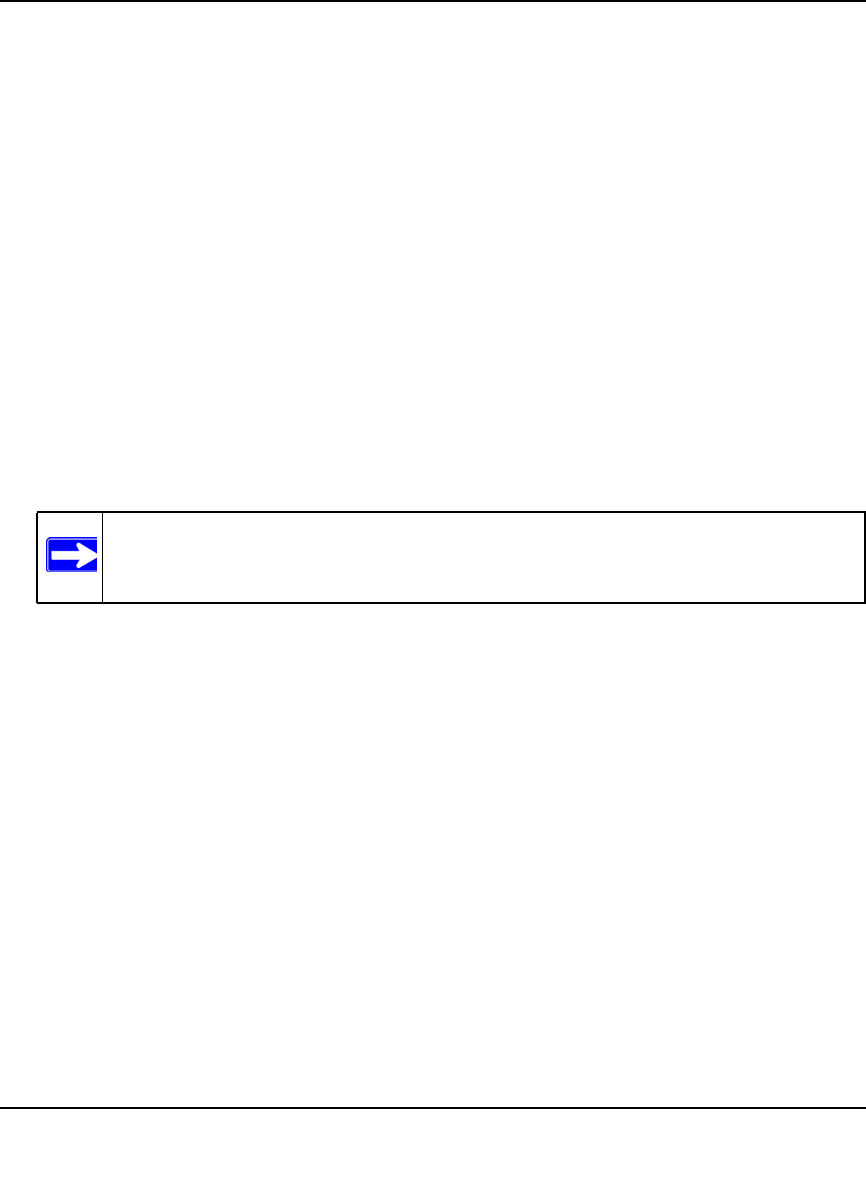
XAVN2001 Powerline AV 200 Wireless-N Extender User Manual
Using the XAVN2001 Powerline Utility 2-11
v1.0, July 2010
Setting Up a Custom Network Encryption Key
When all the devices are set to the default network encryption key and are plugged in, they are
listed on the Device Settings tab. Follow these steps to set up a custom network encryption key for
all the Powerline devices:
1. Select the Device Settings tab to automatically perform a scan to detect the adapter status.
Wait for the new device to be listed. A new device can be identified by its MAC address.
2. From the Advanced Settings tab, click the Security arrow, and check the boxes next to each
device in the Device Name column.
3. Type your network encryption key in the Create a New Encryption Key field.
4. Click Apply Security to Selected Devices.
The utility displays a message indicating that the operation was successful.
5. Select the Device Settings tab to perform a scan.
Verify that all devices are detected with your network encryption key.
For troubleshooting information, see “Problems After Changing Network Encryption Key” in
Appendix B
Note: If one or more of your Powerline devices are not listed, see “Quality of Service
(QoS)” on page 2-13.
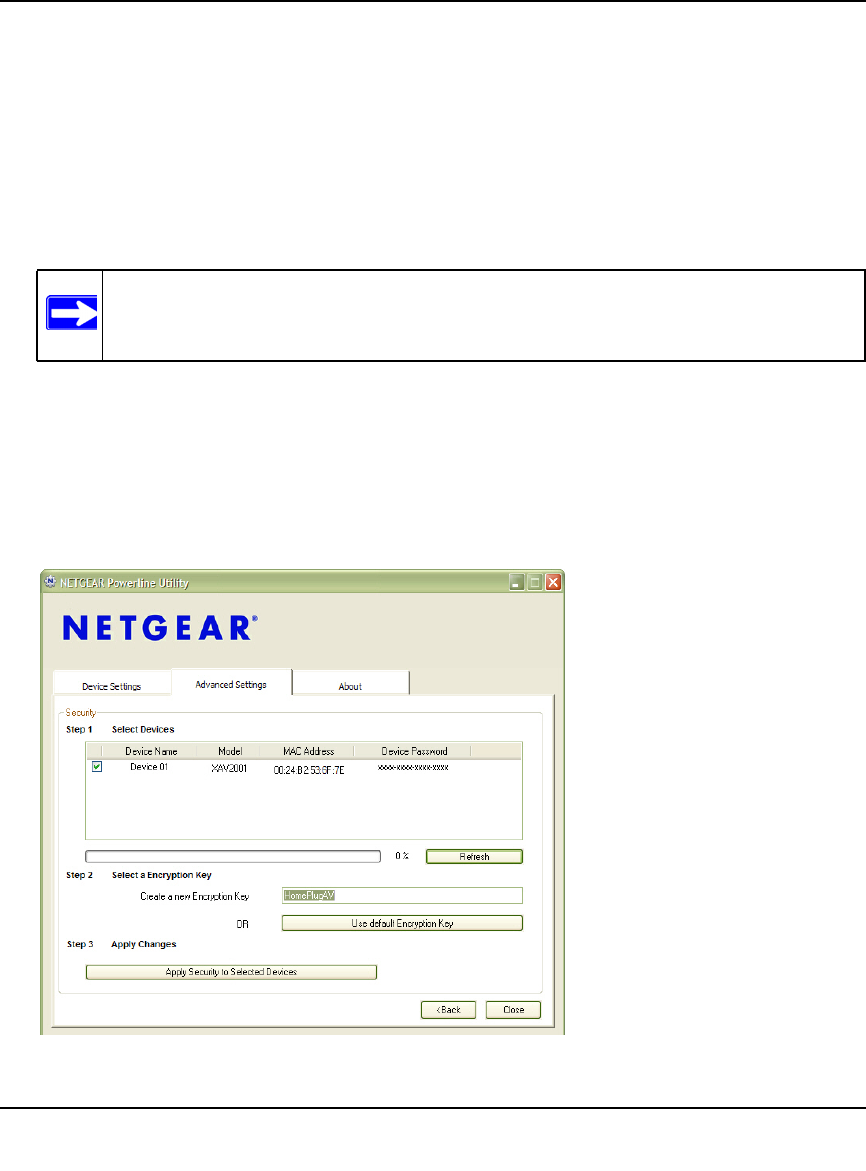
XAVN2001 Powerline AV 200 Wireless-N Extender User Manual
2-12 Using the XAVN2001 Powerline Utility
v1.0, July 2010
Returning to the Default Network Encryption Key
1. Plug the new device into an AC power outlet.
2. Start the XAVN2001 Powerline Utility
• Wait for the utility to detect the devices in your Powerline network.
• Check that all the devices in the established network are displayed on the Device Settings
tab.
3. From the Advanced Settings tab, click the Security arrow, and from the Device Name
column, check the box next to each device you want to set.
4. Click the Use Default Encryption Key button.
You will see the default encryption key, HomePlugAV, display in the encryption field.
5. Click Apply Security to Selected Devices.
Note: Before you can reset a remote device, you must enter its password. The
password is printed on the product label located on the back of the adapter.
Figure 2-9
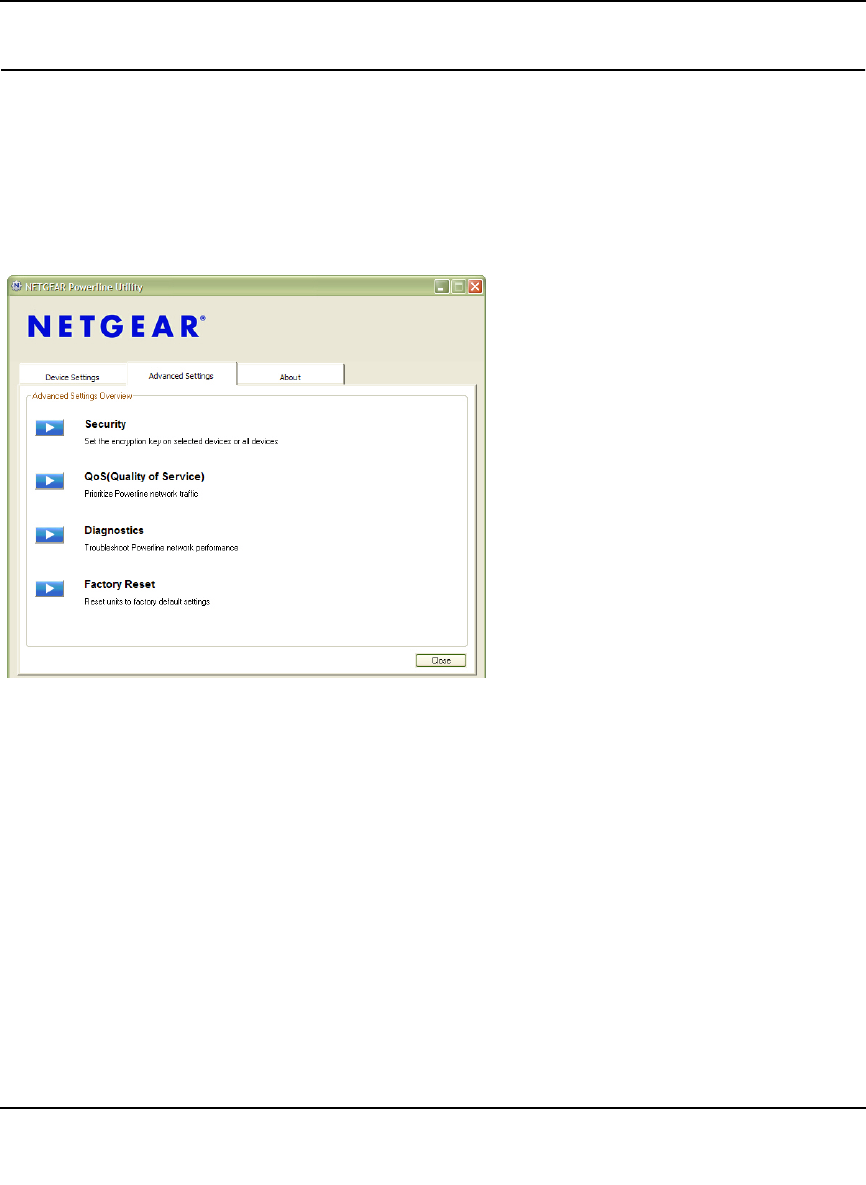
XAVN2001 Powerline AV 200 Wireless-N Extender User Manual
Using the XAVN2001 Powerline Utility 2-13
v1.0, July 2010
Quality of Service (QoS)
From the Advanced Settings tab on the Powerline Utility, click the QoS link to help you prioritize
your Powerline network traffic.
By default, all types of traffic on the Powerline network are assigned the same priority. For most
applications, this works fine. However, there are situations where performance improves if you
assign a higher priority to certain types of traffic, such as multimedia files.
Prioritizing by General Application Type
If your network traffic is a mix of multimedia and document/database traffic you might want to
give priority to a particular traffic type. If it is important that your multimedia playback is smooth,
even while document files are being transferred over the network, then give priority to multimedia
traffic. Conversely, if it is more important for your network to be responsive to database
applications, give priority to this type of application over multimedia applications.
The Powerline AV 200 Wireless-N Extender supports the following:
• MAC address
• IP port
• VLAN tags
• ToS bits (Type of Service routing)
Figure 2-10
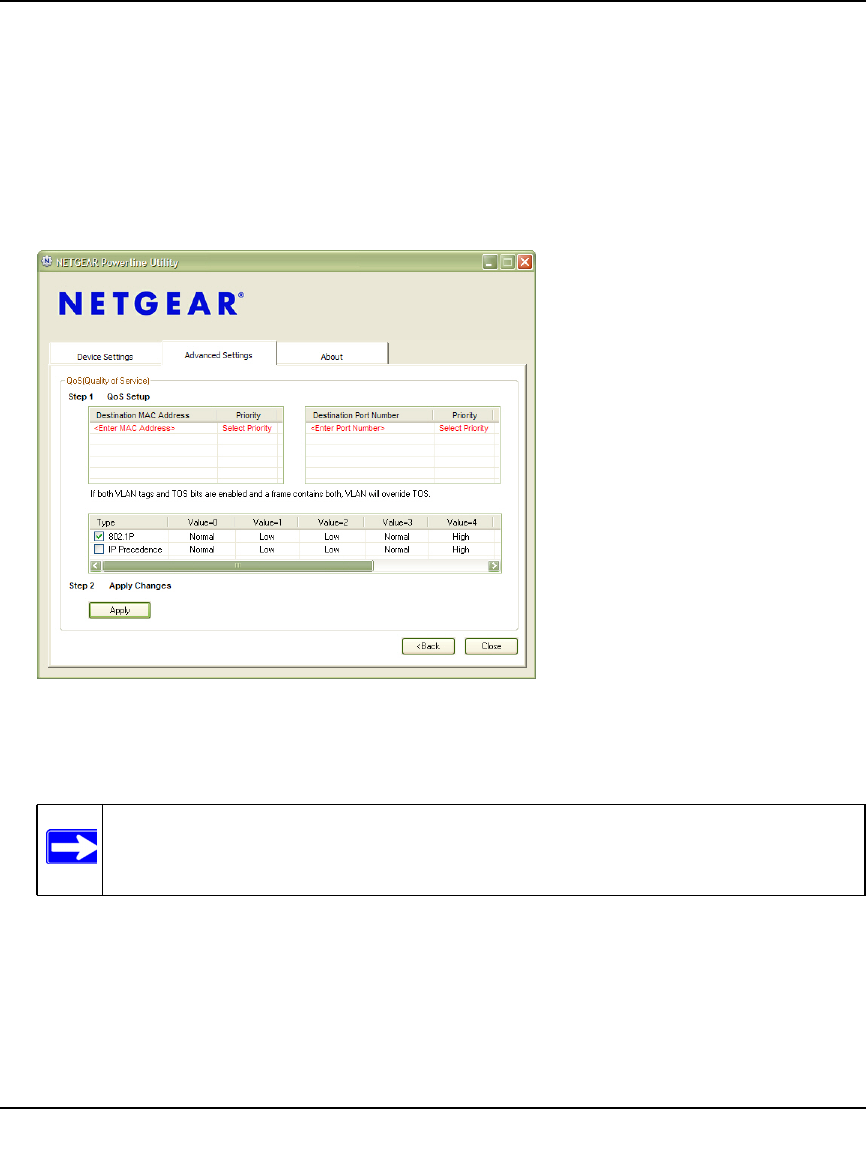
XAVN2001 Powerline AV 200 Wireless-N Extender User Manual
2-14 Using the XAVN2001 Powerline Utility
v1.0, July 2010
To set the priority of data transfers by the type of protocol:
1. Start the XAVN2001 Powerline Utility and wait for the utility to detect the Powerline AV 200
Wireless-N Extenders connected to the network.
2. From the Advanced Settings tab, the Advanced Settings tab, click the QoS arrow.
3. To set the traffic prioritization rule into the selected Powerline AV 200 Wireless-N Extender
device, specify the priority in the QoS Setup section of the screen.
4. Click Apply.
These options only apply to QoS-configured business networks. IEEE 802.1p uses prioritization
bits in Layer-2 frames. Type of Service routing (ToS) uses prioritization bits in Layer-3 IP packets.
The deprecated ToS values range from 0 to 7.
Figure 2-11
Note: QoS settings are applied only to the device that is selected on the QoS tab.
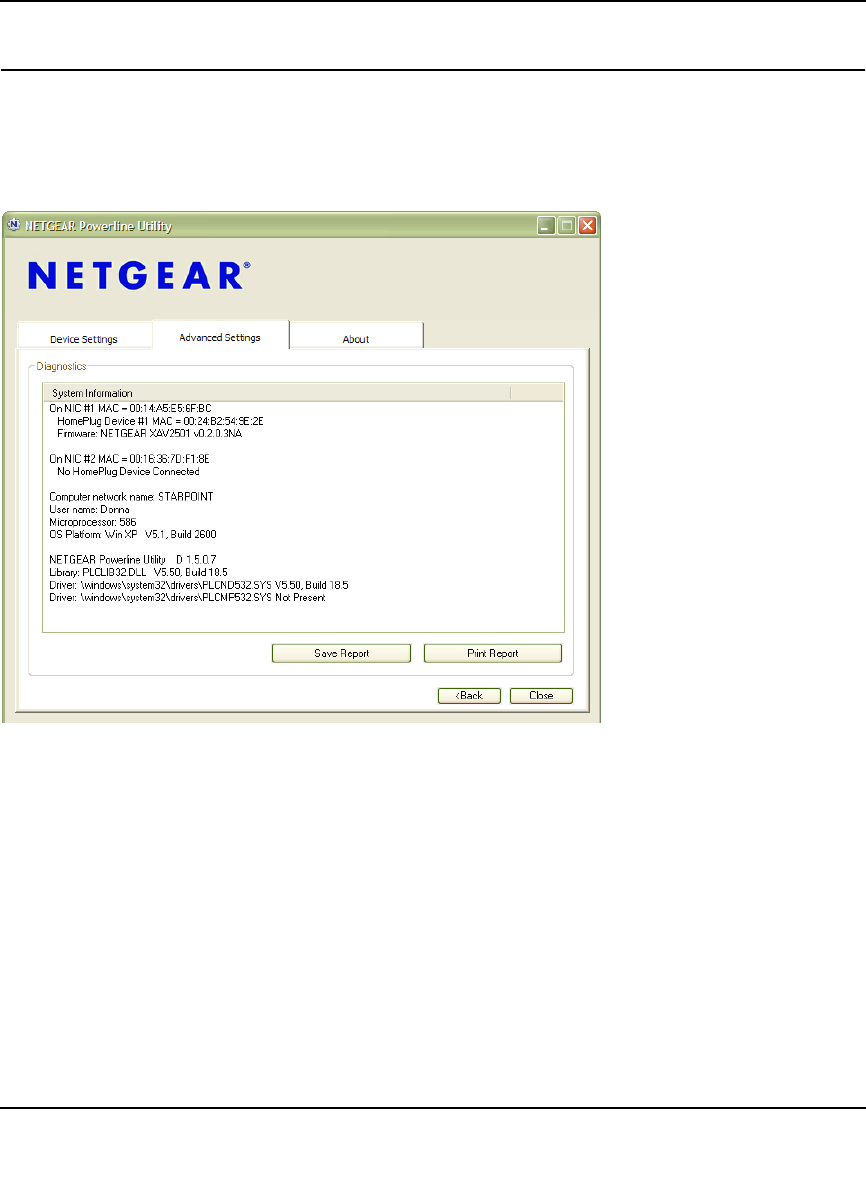
XAVN2001 Powerline AV 200 Wireless-N Extender User Manual
Using the XAVN2001 Powerline Utility 2-15
v1.0, July 2010
Diagnostics
From the Advanced Settings tab on the Powerline Utility, the Diagnostics link helps you diagnose
and troubleshoot performance issues. Using this feature you can delete a device from the device
history, save a report, or print a report.
Figure 2-12
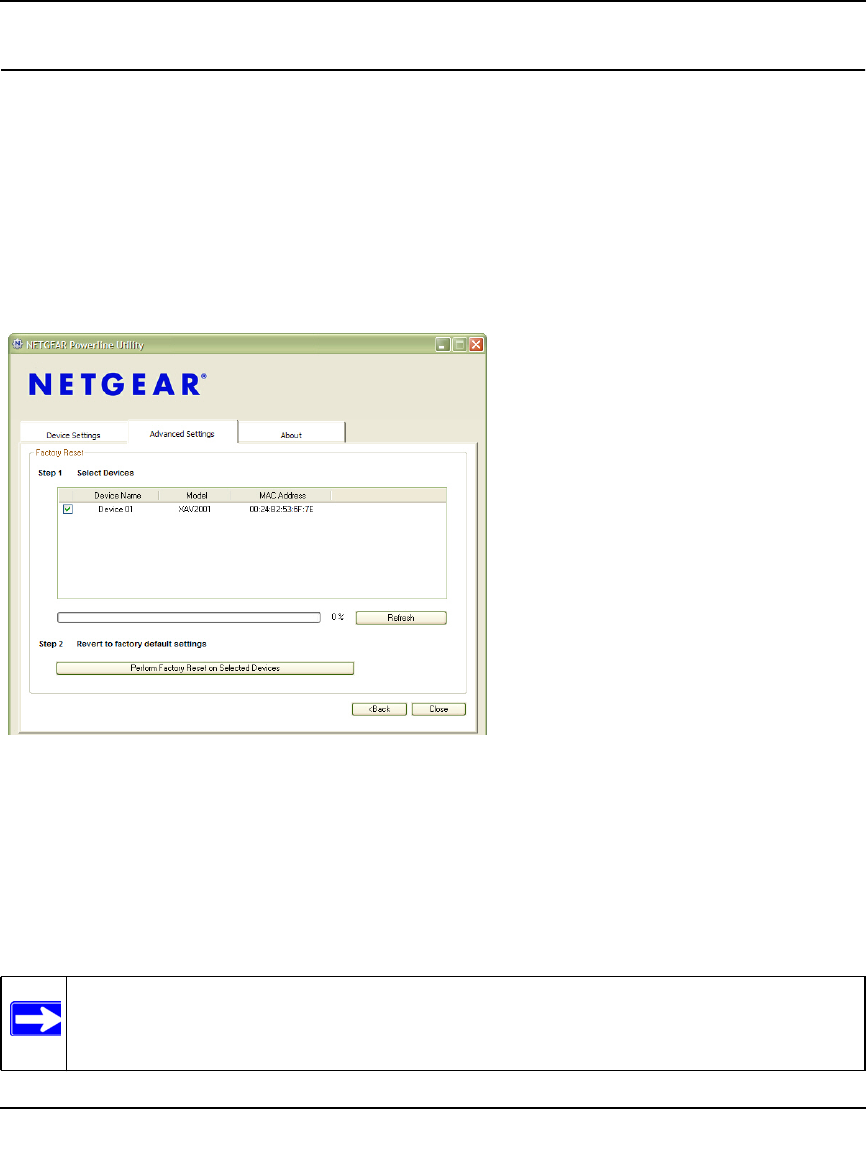
XAVN2001 Powerline AV 200 Wireless-N Extender User Manual
2-16 Using the XAVN2001 Powerline Utility
v1.0, July 2010
Factory Reset
From the Advanced Settings tab on the Powerline Utility, the Factory Reset option returns the
network encryption key to its factory default value of HomePlugAV. Only one device at a time can
be reset.
Resetting to Factory Defaults
1. From the Advanced Settings tab, click the Factory Reset option and select the Powerline
device(s) to be reset.
2. Click the Perform Factory Reset on Selected Devices button. A confirmation message
displays.
3. Click OK to reset the device. A message indicates whether or not the operation succeeded.
4. After you have reset each device, check that the Device Settings tab lists all devices in the
network.
Figure 2-13
Note: If you customized your network encryption key, the local Powerline device will be
disconnected from the network when you reset it to the factory default. To avoid
this problem, reset all remote devices before you reset the local device.

A-1
v1.0, July 2010
Appendix A
Technical Specifications
This appendix provides technical specifications for the XAVN2001 Powerline AV Ethernet
Adapter.
Network Protocol and Standards Compatibility
Data and Routing Protocols: IEEE 802.3 (10BASE-T), IEEE 802.3u (100BASE-Tx)
AC Input 100-240V~, 0.2A (Max)
Power Consumption: 4W
Dimensions: Height: 98 mm
Width: 72 mm
Depth: 40 mm
Weight: 0.4 lbs (0.18 kg)
Environmental Specifications
Operating temperature: 0 to 40 C (32º to 104º F)
Operating humidity: 10-90% maximum relative humidity, noncondensing
Storage humidity 5-95% maximum relative humidity, noncondensing
Security
Encryption type: 128-bit AES
Bridge Performance
MAC addresses: 64
Bandwidth 200 Mbps
Powerline Performance
Compatibility: HomePlug AV
Data Transfer Rate: Up to 200 Mbps with real throughput greater than 80 Mbps
Frequency band: 2-30 Mbps
Modulation type: OFDM symbol modulation
Electromagnetic Emissions
Meets requirements of: FCC Part 15 Class B; CE-EMC Class B; 3-home FCC Certificate;
HomePlug

XAVN2001 Powerline AV 200 Wireless-N Extender User Manual
A-2 Technical Specifications
v1.0, July 2010
Safety Agency Approvals
Meets requirements of: UL Listed (UL 1950) /cUL IEC950; CE LVD; TUV CB; GS

XAVN2001 Powerline AV 200 Wireless-N Extender User Manual
Technical Specifications A-3
v1.0, July 2010
Safety Information: XAVN2001 Powerline AV 200 Wireless-N
Extender
Follow these safety guidelines to ensure your own personal safety and to help protect your system
from potential damage.
• AC input: 100-240V~, 0.2A (Max)
• Operating temperature: 0C~40C
• Maximum Wireless Signal Rate Derived from IEEE Standard 802.11 Specifications
• Actual data throughput will vary. Network conditions and environmental factors, including
volume of network traffic, building materials and construction, and network overhead, lower
actual data throughput rate.
• Observe and follow service markings.
• Do not service any product except as explained in your system documentation.
• Opening or removing covers that are marked with the triangular symbol with a lightning bolt
may expose you to electrical shock. Only a trained service technician should service
components inside these compartments.
• If any of the following conditions occur, unplug the product from the electrical outlet and
replace the part or contact your trained service provider:
• The power cable, extension cable, or plug is damaged.
• An object has fallen into the product.
• The product has been exposed to water.
• The product has been dropped or damaged.
• The product does not operate correctly when you follow the operating instructions.
• Keep your system away from radiators and heat sources. Also, do not block cooling vents.
• Do not spill food or liquids on your system components, and never operate the product in a wet
environment. If the system gets wet, contact your trained service provider.
• Do not push any objects into the openings of your system. Doing so can cause fire or electric
shock by shorting out interior components.
• Use the product only with approved equipment.
• Allow the product to cool before removing covers or touching internal components.

XAVN2001 Powerline AV 200 Wireless-N Extender User Manual
A-4 Technical Specifications
v1.0, July 2010
• Operate the product only from the type of external power source indicated on the electrical
ratings label. If you are not sure of the type of power source required, consult your service
provider or local power company.
• To help avoid damaging your system, be sure that the voltage selection switch (if provided) on
the power supply is set to match the power available at your location:
• 110 volts (V), 60 hertz (Hz) in most of North and South America and some Far Eastern
countries such as South Korea and Taiwan
• 100 V, 50 Hz in eastern Japan and 100 V, 60 Hz in western Japan
• 230 V, 50 Hz in most of Europe, the Middle East, and the Far East
• Be sure that attached devices are electrically rated to operate with the power available in your
location.
• To help prevent electric shock, plug the system and peripheral power cables into properly
grounded electrical outlets.
• Use only approved power cables. If you have not been provided with a power cable for your
system or for any AC powered option intended for your system, purchase a power cable that is
approved for use in your country. The power cable must be rated for the product and for the
voltage and current marked on the product’s electrical ratings label. The voltage and current
rating of the cable should be greater than the ratings marked on the product.
• The peripheral power cables are equipped with three-prong plugs to help ensure proper
grounding. Do not use adapter plugs or remove the grounding prong from a cable.
• Observe extension cable and power strip ratings. Make sure that the total ampere rating of all
products plugged into the extension cable or power strip does not exceed 80 percent of the
ampere ratings limit for the extension cable or power strip.
• To help protect your system from sudden, transient increases and decreases in electrical
power, use a surge suppressor, line conditioner, or uninterruptible power supply (UPS).
• Position system cables and power cables carefully; route cables so that they cannot be stepped
on or tripped over. Be sure that nothing rests on any cables.
• Do not modify power cables or plugs. Consult a licensed electrician or your power company
for site modifications.
• Always follow your local and national wiring rules.
• Move products with care; ensure that all casters and stabilizers are firmly connected to the
system. Avoid sudden stops and uneven surfaces.

B-1
v1.0, July 2010
Appendix B
Troubleshooting
This chapter provides information about troubleshooting your XAVN2001 Powerline AV 200
Wireless-N Extender.
Product Registration and Support
Thank you for selecting NETGEAR products.
After installing your device, locate the serial number on the label of your product and use it to
register your product at http://www.NETGEAR.com/register. Registration is required before you
can use our telephone support service. Registration via our website is strongly recommended.
Product updates and Web support are always available at: http://www.netgear.com/support. For
Warranty and Regional Customer Support information, see the Resource CD that came with your
product.
Basic Functioning
After you turn on power to the XAV2001 devices, the following sequence of events should occur:
1. When power is first applied, verify that the Power light is on.
2. After approximately 10 seconds, verify that:
a. The power light is solid green.
b. The Powerline LED is lit.
c. The Ethernet light on the Powerline AV 200 Wireless-N Extender lights or blinks.

XAVN2001 Powerline AV 200 Wireless-N Extender User Manual
B-2 Troubleshooting
v1.0, July 2010
LED Troubleshooting Tips
Table B-1. LED and Feature Troubleshooting
Problem Recommendation
Power light is off. Make sure that power is supplied to the electrical outlet, and the Powerline
device is not plugged into an extension cord, power strip, or surge protector.
Power LED is amber. The adapter enters power saving mode if the Ethernet port is not linked for
more than 10 minutes. It goes back to normal mode when the Ethernet port
is linked.
Powerline light is off. Powerline devices cannot find each other. Make sure that the Powerline
devices are plugged into outlets with power, and that they use the same
network encryption key.
• Move the Powerline device to a location closer to the computer or
devices.
• If you have set up network security, make sure that all Powerline devices
are using the same encryption key; see the online User Manual for
details.
• If the problem occurred after you changed the network encryption key,
reset each device to their factory default settings. If this fixes the problem,
see the User Manual for instructions about setting the network encryption
key.
Ethernet light is not
blinking. There is no data traffic. Make sure that:
• Your router and modem are switched on.
• The Ethernet cable that came in the box are working and securely
connected to the Powerline adapter port and a router LAN port.
• The PC connected directly to the router can access the Internet.
• Press the Reset button on each device for 1 second to return the
Powerline adapter to its factory default settings
Problem using the Reset or
Security button. The Reset and Security buttons are located on the side panel of the
Powerline AV 200 Wireless-N Extender.
• Pressing the reset button longer than 2 seconds will not reset the device.
• Pressing the Security button longer than 2 seconds will not activate
security.
• See the User Manual for instructions on using the Reset and Security
buttons.
All LEDs are off when
plugged into the AC line. • check the Powerline utility, if see if the LEDs are turned via the software. If
so, then use the Powerline utility to turn them back on.
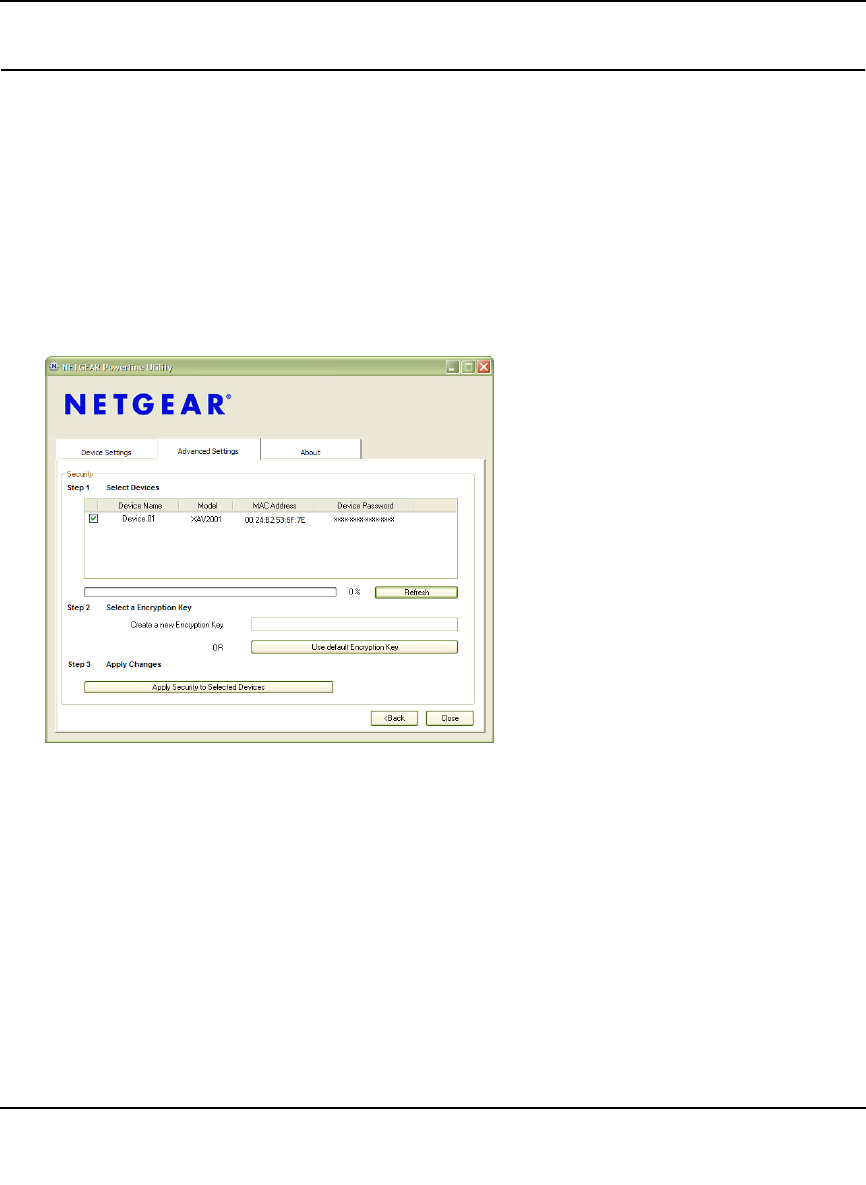
XAVN2001 Powerline AV 200 Wireless-N Extender User Manual
Troubleshooting B-3
v1.0, July 2010
Problems After Changing Network Encryption Key
.If your Powerline devices stop communicating after you have used the NETGEAR XAVN2001
Powerline Utility, you’ll need to change the network encryption key.
To change the network encryption key:
1. Open the XAVN2001 NETGEAR Powerline Utility and select the Security option on the
Advanced tab.
2. Select the device.
For each remote device, enter its password (printed on the product label), and then select it.
3. Click the Use Default Encryption Key button.
4. Click the Apply Security to Selected Devices button.
5. Select the Device Settings tab, and check that the utility detects all the Powerline AV 200
Wireless-N Extenders in your Powerline network.
If the utility detects all your Powerline devices, you can specify a new network encryption key
as described in “Adding a Device to a Powerline Network” in Chapter 2.
If the utility does not detect them all, see the following section, “Changing the Network
Encryption Key for One Unit at a Time”.
Figure B-1

XAVN2001 Powerline AV 200 Wireless-N Extender User Manual
B-4 Troubleshooting
v1.0, July 2010
Changing the Network Encryption Key for One Unit at a Time
If the Powerline Utility does not detect all the devices in your network, you must connect your
computer to each Powerline device and set up the network encryption key one adapter at a time, as
follows:
1. From the Advanced Settings tab, click the Security arrow.
2. Select the first Powerline adapter in your network.
3. In the Select an Encryption Key area, type the network encryption key that you want to
assign to the adapter in the Create a new Encryption field.
4. Click the Apply Security to Selected Devices button.
5. Repeat for each device in the network.
6. Select the Device Settings tab to automatically scan for Powerline Devices.
Check that the utility detects all the devices that have been individually set to the same
network encryption key.

Index i
v1.0, July 2010
Index
A
AC Input 1
add a device, local 7
add a device, remote 8
add adapters 6
advanced settings 9
B
bandwidth 1
basic configuration 1
basic functioning 1
button descriptions 3
C
change encryption key 3
compatibility 1
customer support 1
D
data transfer rate 1
default encryption key 12, 3
device names 6
device settings 5
diagnostics 15
dimensions 1
E
electromagnetic emissions 1
encryption
change default 8
encryption key
change one at a time 4
changing 10
custom 11
default 12
encryption type 1
ethernet
network extension 1
EU Declaration of Conformity iii
example, Powerline network 1
F
factory reset 16
FCC statement iii
features 2
frequency band 1
front panel 2
H
humidity
operating, storage 1
I
install
Powerline utility 2
installation 1
L
LED 6
descriptions 3
LED troubleshooting 2

XAVN2001 Powerline AV 200 Wireless-N Extender User Manual
Index ii
v1.0, July 2010
M
MAC address 6
Mbps 6
model 6
modulation type 1
P
Powerline utility
install 2
Powerline AV Ethernet Adapter
features 2
install 4
Powerline utility
launch 4
shortcut icon 4
update 3
using 1
product registration 1
Q
QoS 13
quality 6
quality of service 13
R
rear panel 2
registration 1
reset 16
resource CD 2, 1
router, connect to adapter 5
S
safety agency approvals 1
safety information 2
security 9
understanding 7
set data transfer priority 14
shortcut icon 4
side panel 2
support ii, 1
T
technical specifications 1
temperature 1
trademarks ii
troubleshooting 1
U
UL listed 1
update Powerline utility 3
W
weight 1